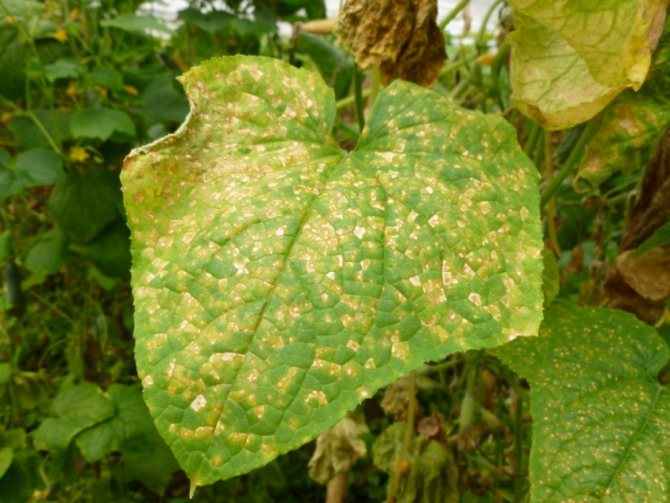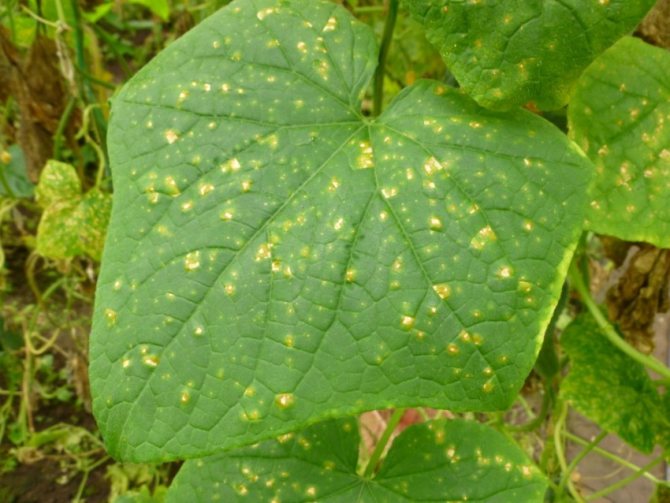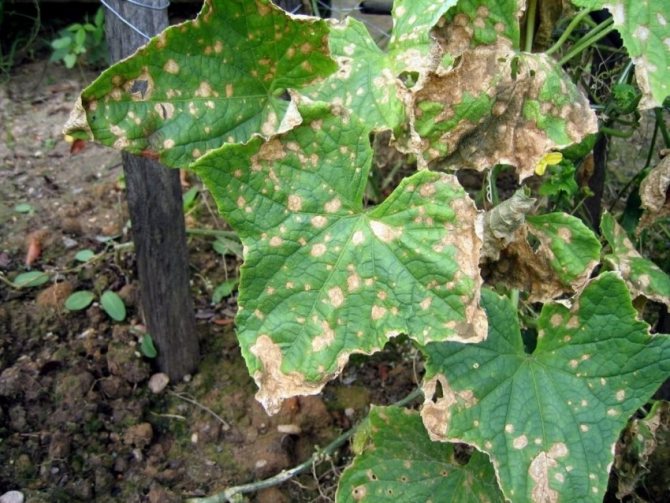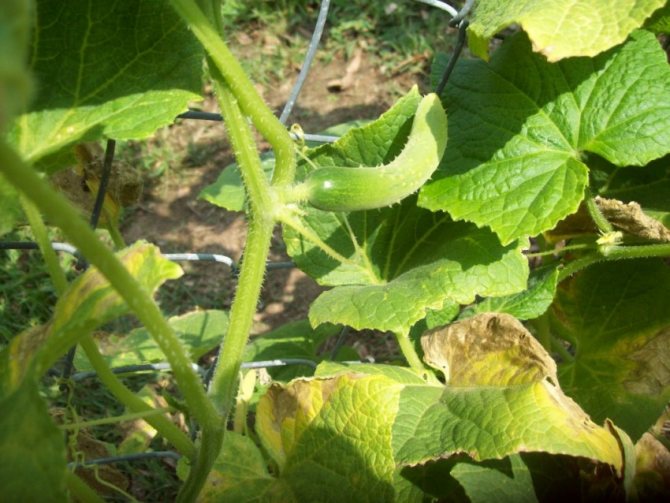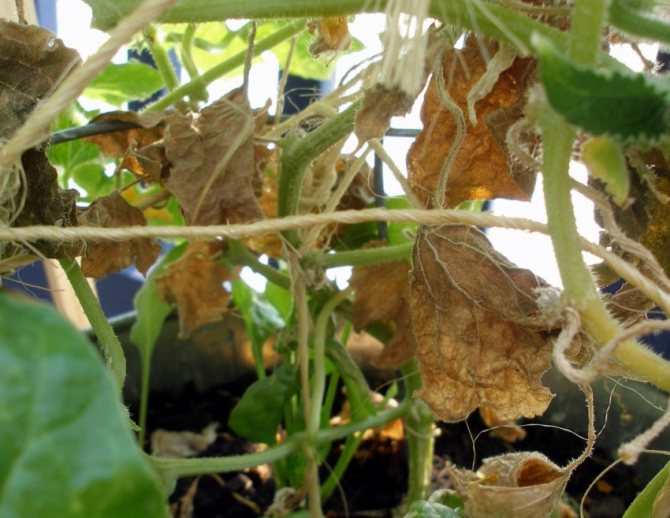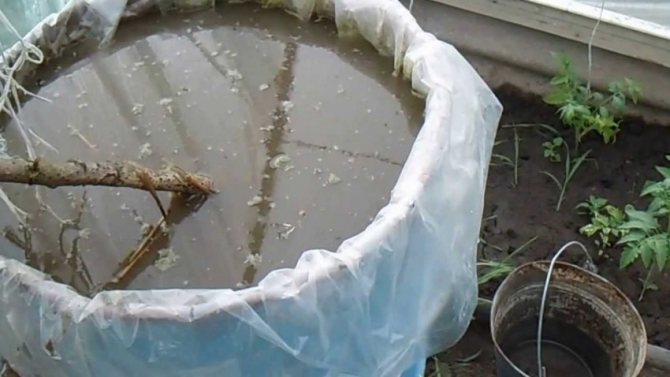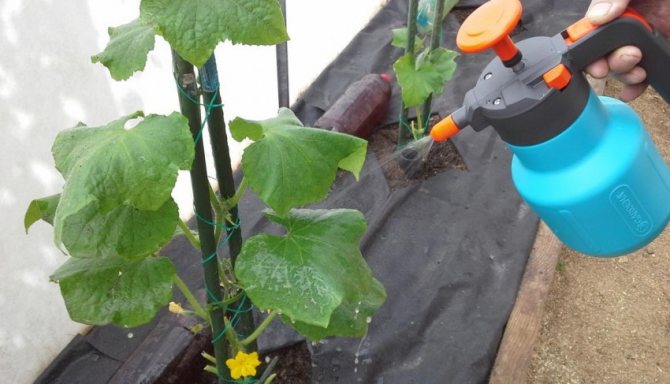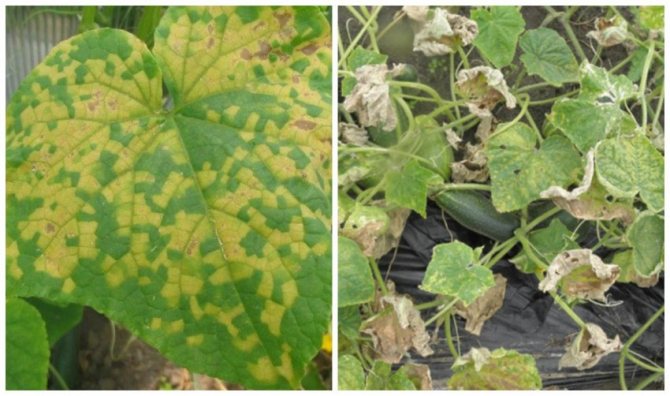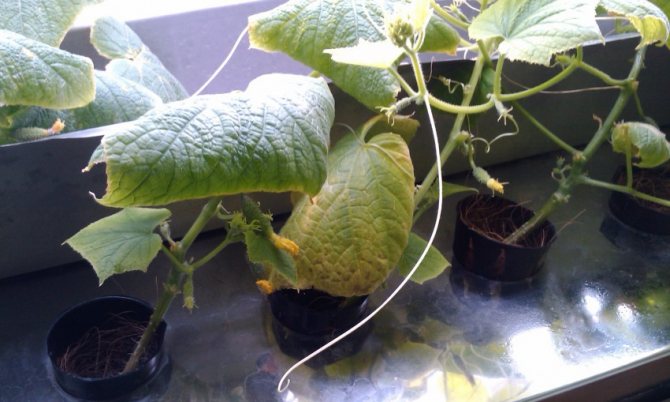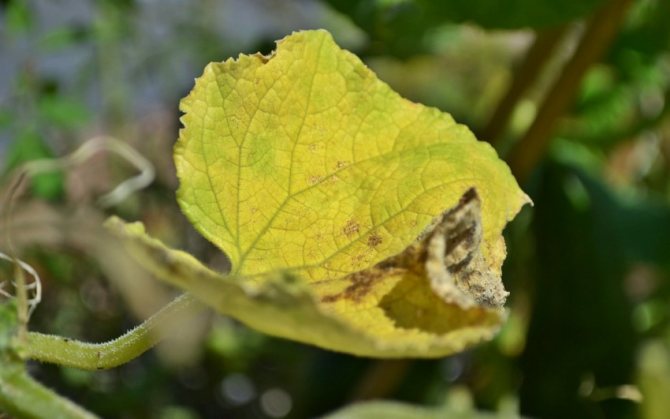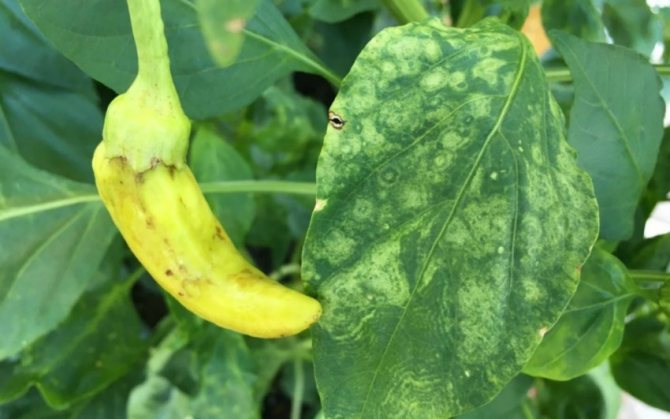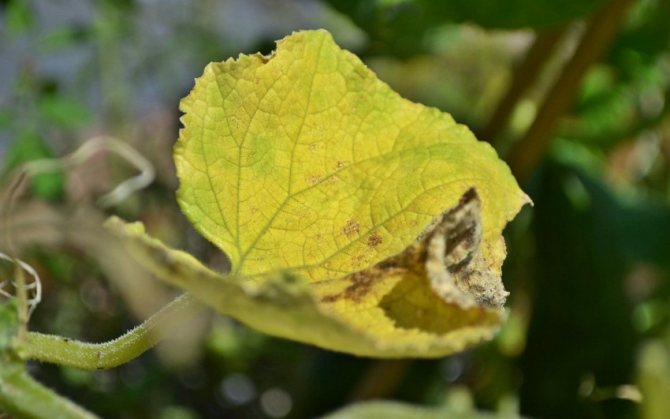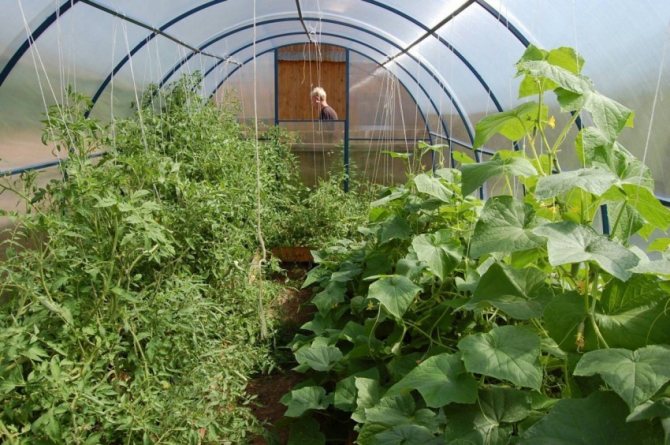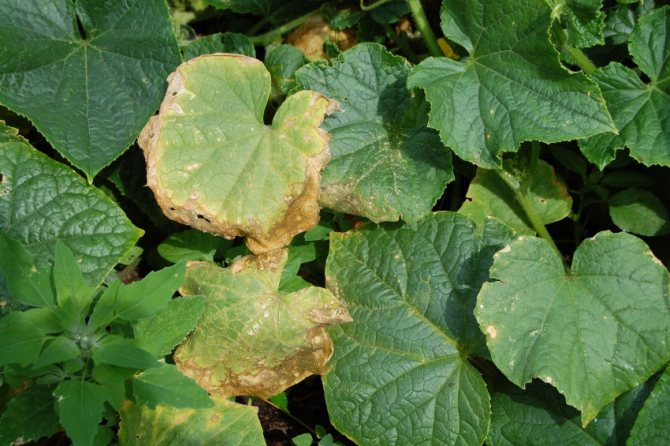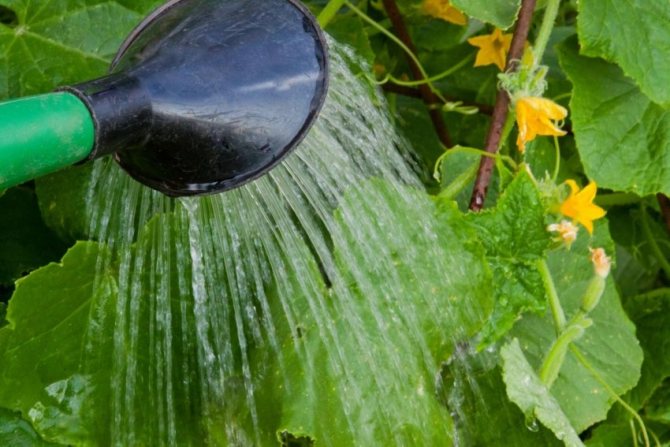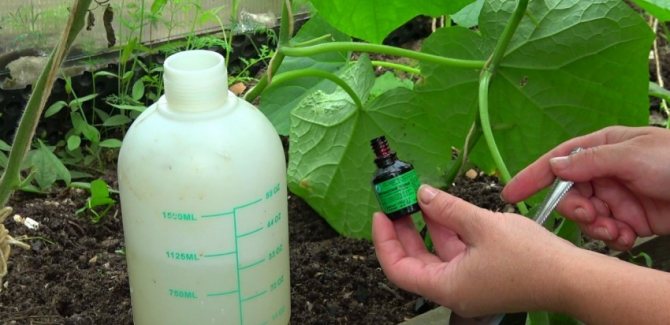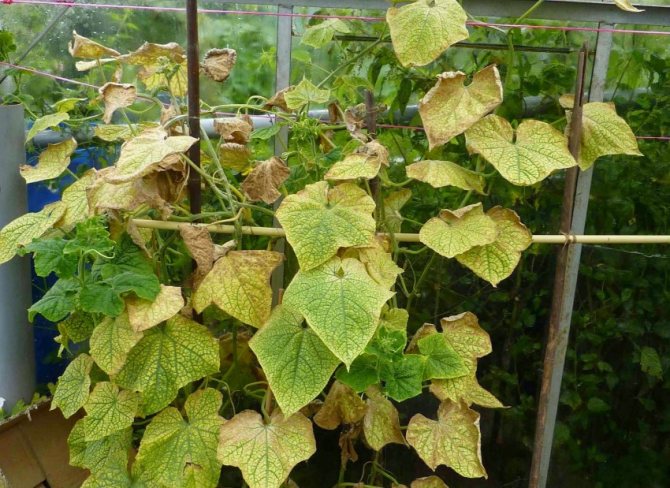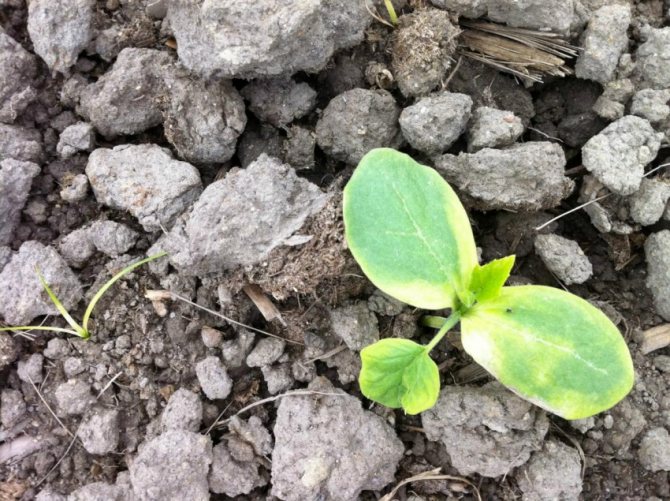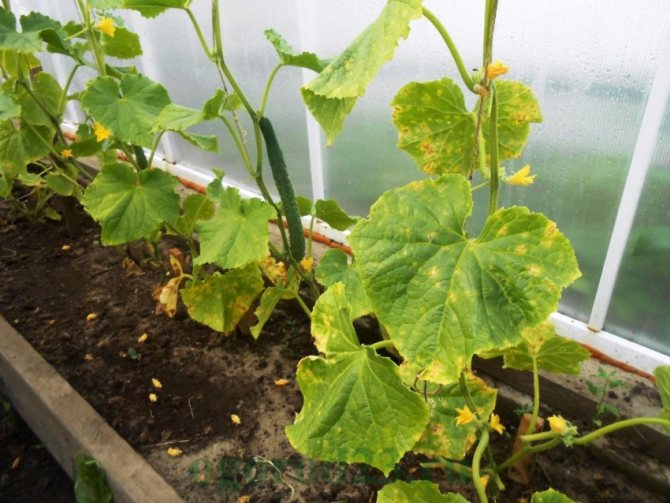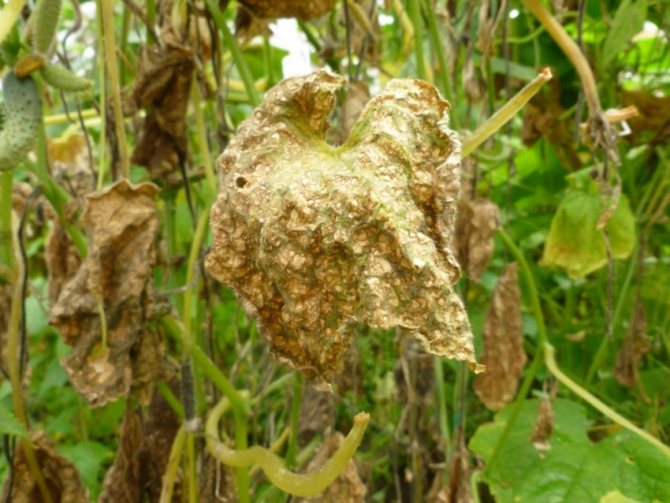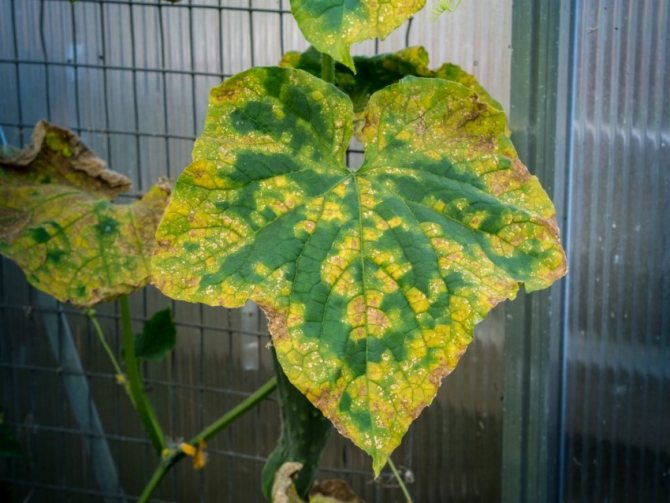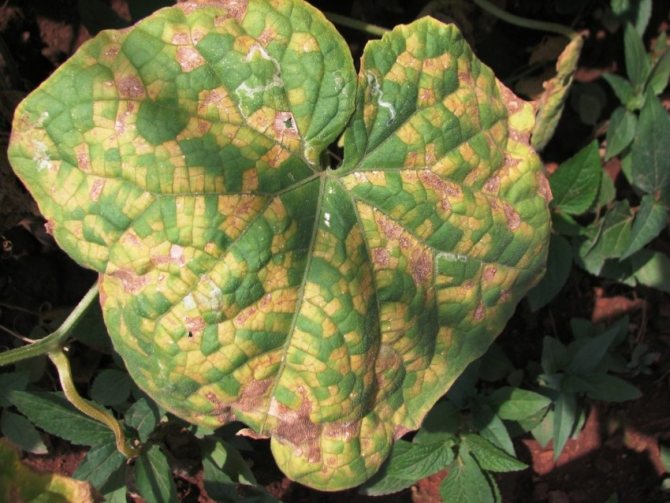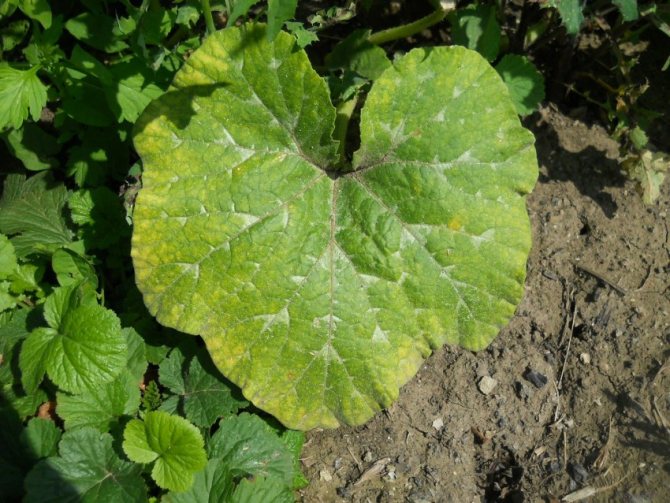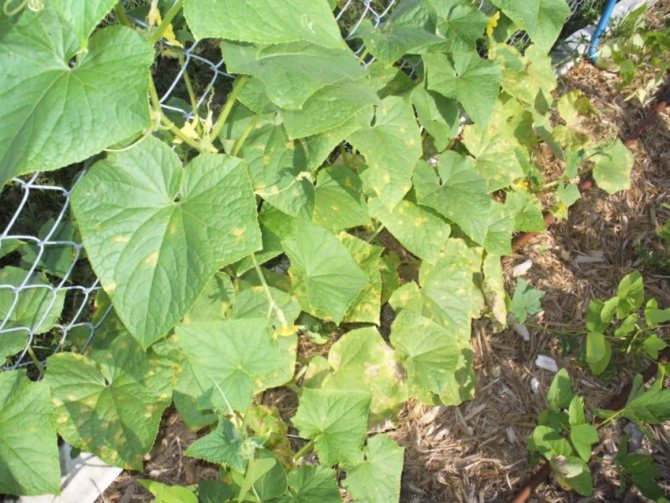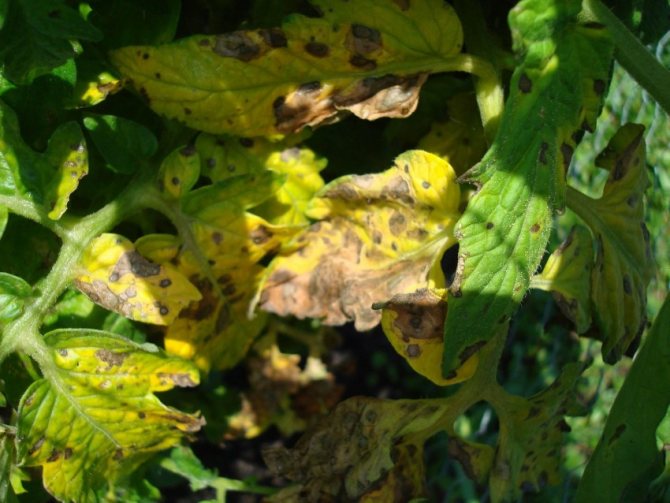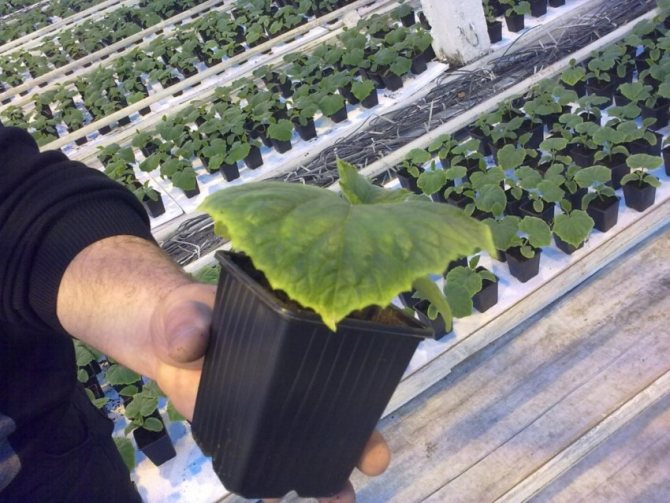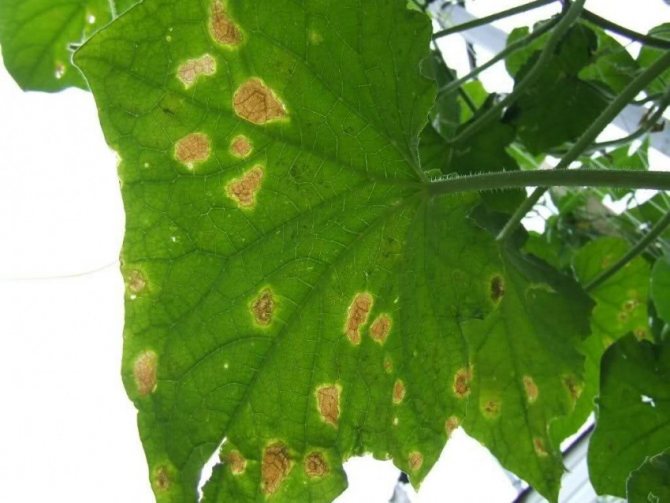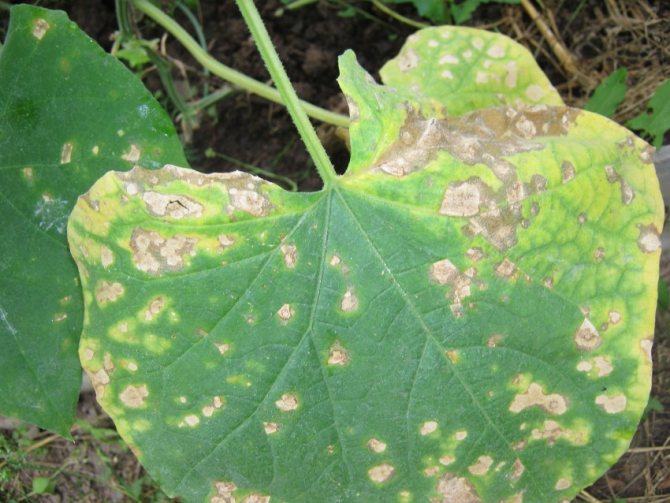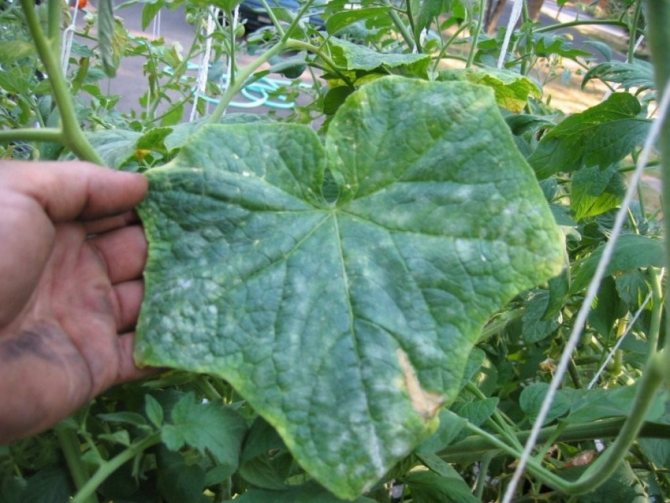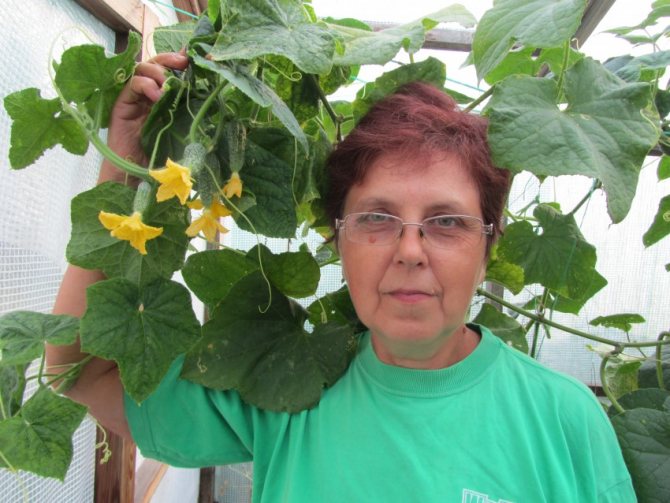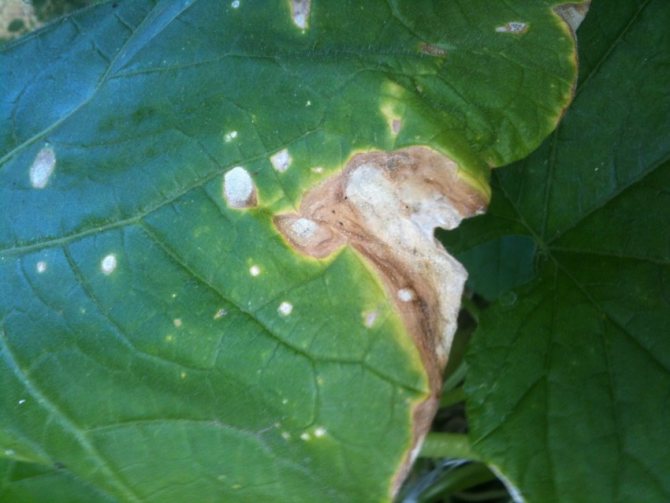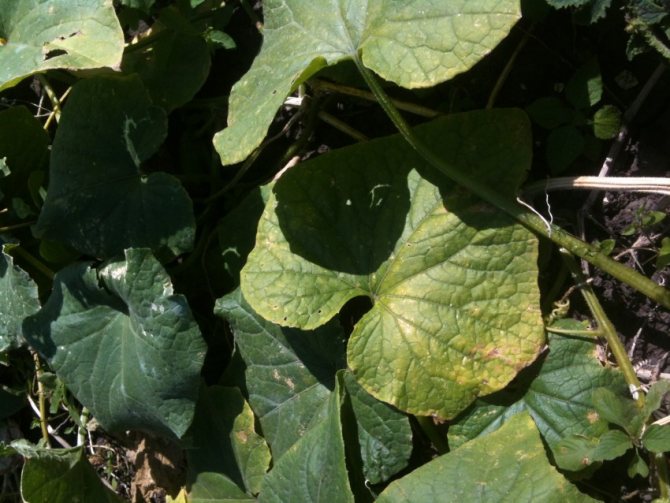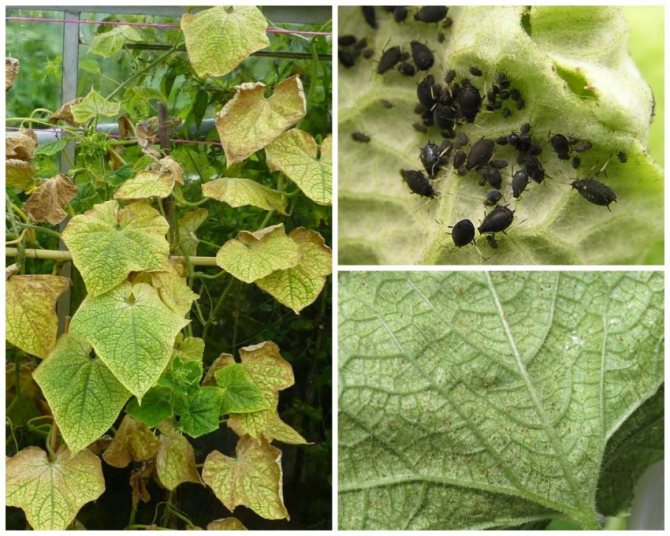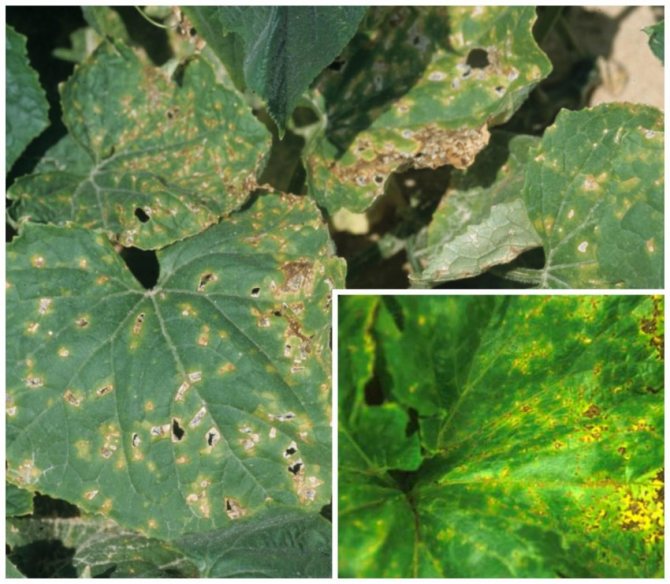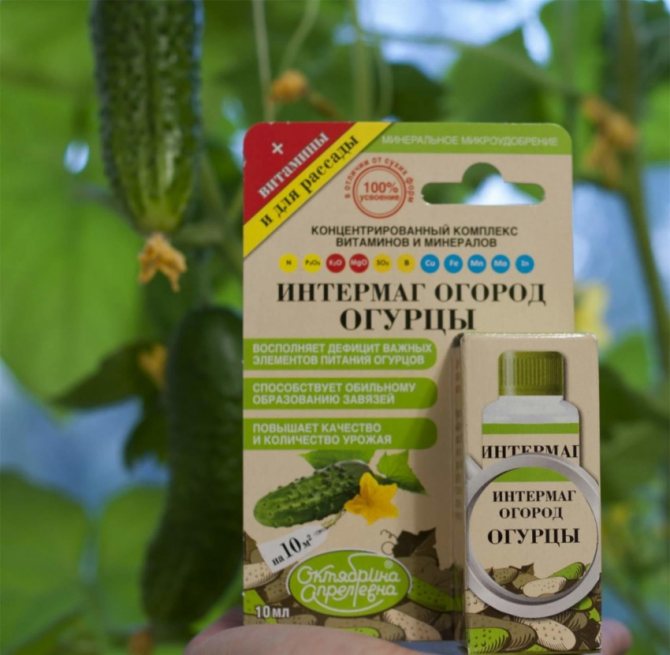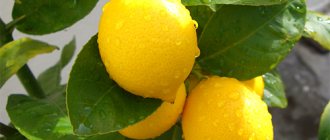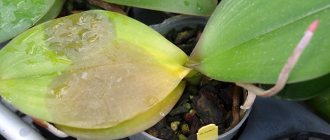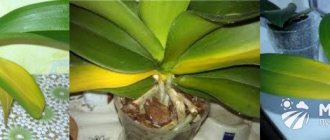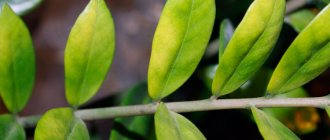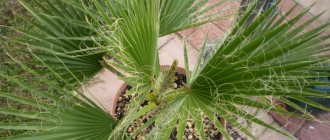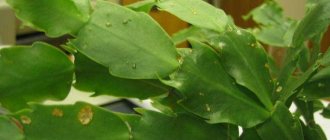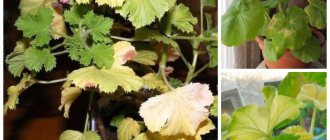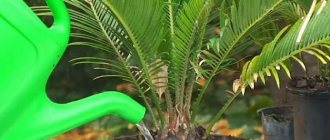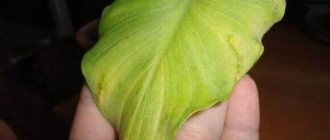Today, almost every gardener is engaged in the cultivation of cucumbers. And this is not surprising, because cucumbers are a fairly common vegetable crop. Its fruits can be consumed both fresh and canned. But you need to understand that, like any crop, cucumbers need careful care. Yellow leaves are considered one of the most common problems. What to do if the leaves of cucumbers began to turn yellow, and what folk remedies can be used, is described in this article.
The main causes of yellowing
Climatic conditions
Often, the color of the leaves on cucumber bushes changes due to unfavorable climatic conditions. In this case, the reason can be both in too much heat, and in a sharp temperature drop.
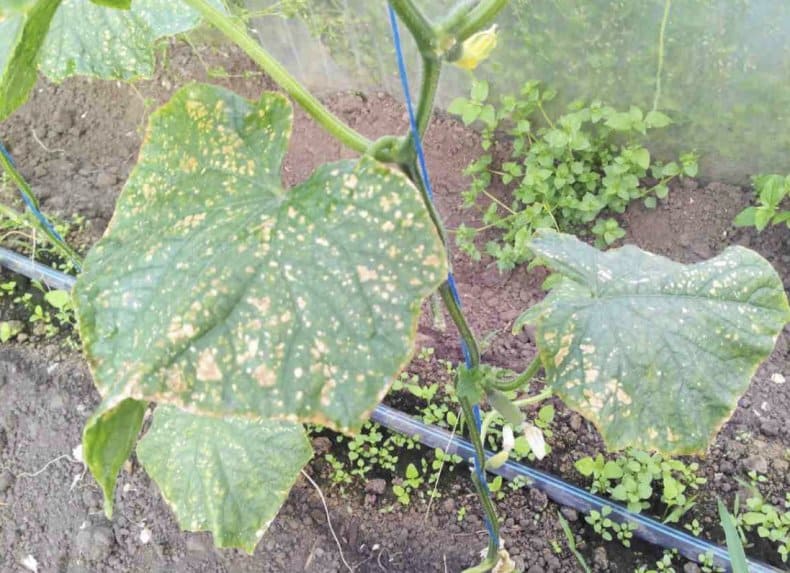
Sunburn
In calm weather, direct sunlight overheats the sheet plates and leaves burns on them. This happens especially often if you water cucumbers in the heat and allow drops of water to get on the plant.
Temperature fluctuations are also often the cause of the development of fungal diseases.
Alas, you cannot fight nature in any way. But you can help plants survive adverse conditions. If a sharp drop in temperature is expected, treat the cucumbers with a growth stimulant or "Fitosporin"... You can also cover plantings with spunbond.
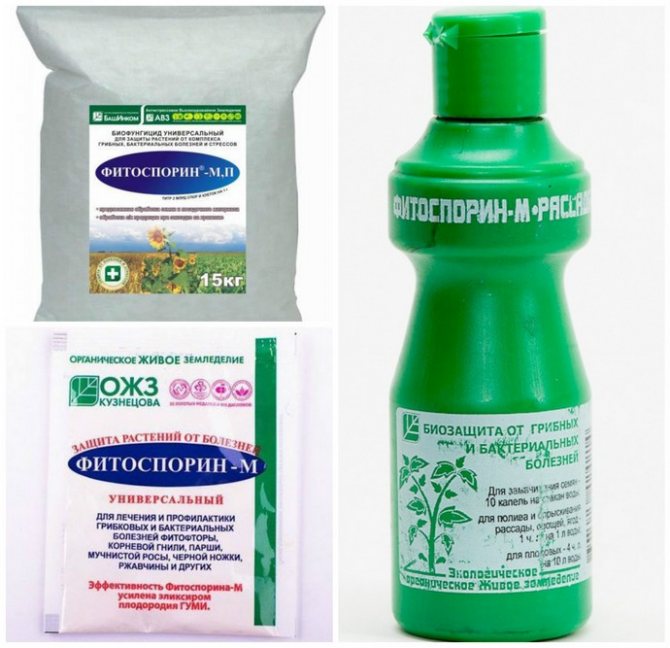

Fitosporin
Improper watering
Cucumbers are very fond of moisture, but they need to be watered, carefully observing the watering regime.
- Do not use cold water from the mains.
- Watering should be done in the morning or evening.
- Water should be poured at the root, trying to avoid moisture getting on the leaves and stems.
IMPORTANT! Try to water your cucumbers regularly and with about the same amount of water.
Lack of nutrients
So that the cucumbers do not get sick, the leaves are green, and the stems are strong, there should be at least 3 basic dressings:
- When 2 real leaves appear.
- At the time when the plant blooms.
- When the fruits begin to set.
Cucumbers prefer liquid blends and blends. They are better absorbed by the plant.
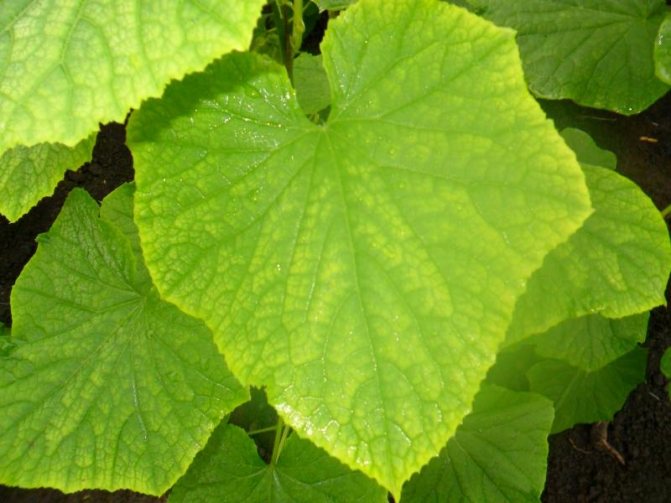

Lack of nutrients
Experienced gardeners recommend using infusions of weeds or herbal tea as a fertilizer during the fruiting period. Such dressings have a good effect on fruit setting and do not negatively affect the taste of cucumbers.
Excess micronutrients
An excess of trace elements is even more dangerous for cucumbers. Therefore, fertilizing the plant must be carried out exactly following the instructions on the fertilizing package.
Diseases and pests
The change in the color of the leaf plates is a consequence of pityosis and fusarium. These are fungal diseases in which dark spots appear first, and only then complete yellowing occurs.
The fungus usually appears after a temperature drop. Therefore, for prevention, process the planting "Fitosporin".
Among pests, the main enemies of cucumbers are spider mites and whiteflies. These insects feed on plant juices, which causes yellowing and wilting of foliage. To get rid of pests, use drugs Fitoverm, "Anti-tick", Apollo.
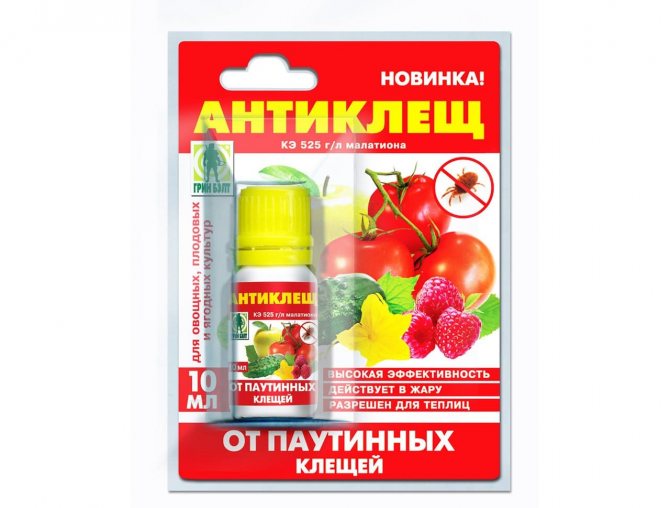

Anti-mite
The main pests of cucumbers
Various pests of cucumber plants, for example, aphids, spider mites, sucking the juice from the leaf tissue, cause it to turn yellow, curl and dry out.
There is only one way to deal with this cause - by destroying pests. As a solution for spraying, both a folk remedy and a special chemical preparation are suitable.
Melon aphid
Melon aphid - These pests of cucumbers damage the shoots, flowers, ovaries and the underside of the leaf, causing them to shrivel and curl. Appears in the second half of summer. At first it is yellowish, then it becomes dark green, develops very quickly, literally in a few days it envelops the entire underside of the leaves, as well as the ovaries and flowers. As a result of the defeat, the leaves wrinkle, deform, young buds fall off. The cucumber bush practically stops growing, then dries up and dies. Aphids are dangerous not only in themselves - they carry many dangerous microorganisms, for example, sooty fungus.
Control measures: destroy all weeds on the site, since aphids only move from weeds.
Folk methods of dealing with aphids
To remove aphids, you can treat the leaves with an infusion of fresh hot red pepper. To do this, take 30 g of fresh chopped paprika and 200 g of tobacco dust for 10 liters of hot water (60 ° C). Insist for a day, then stir well and strain. Add 1 tbsp to the finished infusion. a spoonful of liquid soap and 2-3 tbsp. spoons of wood ash. Spend 1-2 liters per 1 square meter, depending on the number of aphids. Spraying is repeated after 6-7 days.
You can also treat the plants with a solution of ash and soap: pour 2 cups of wood ash into 10 liters of hot water, add 1 tbsp. a spoonful of liquid soap and leave for a day, then filter and spray the plants in warm, calm weather.
Spider mite
A spider mite on cucumbers is capable of exterminating cucumber crops with its gluttony and fertility. It is difficult to get rid of it due to its quick addiction to chemicals.
The spider mite is very small in size, it is almost impossible to notice it. As a rule, only traces of insect activity are visible. The mite multiplies quickly and infects the leaves. Leaves, devoid of juice, change green to lemon, wither, and then fall off. The following signs indicate the appearance of a spider mite on cucumbers:
- light dots (with a large lesion - spots) on the back of the leaf;
- almost transparent cobweb on the plant; slowdown in growth;
- yellowing of the leaves.
Spider mites appear mainly in greenhouses. Especially if the greenhouse has a closed and unventilated space with dry hot air.
It is possible to process cucumbers against spider mites with chemicals only before the fruits appear, and then you need to use folk remedies.
And it is imperative to create conditions unfavorable for the life of the spider mite.
Traditional methods of dealing with spider mites
- Garlic solution: 50 gr. Pour 0.5 liters of water into the chopped cloves, stir thoroughly. Close hermetically and let it brew. After a day, strain, pour into a bucket of water and you can spray the cucumbers. You also need to process the soil and walls of the greenhouse;
- hot pepper solution: fresh or dried. Cook in the same way as a garlic solution;
- If there is tobacco dust, you can spray it on the leaves, after sprinkling them with water;
Whitefly
Whitefly is a very dangerous pest of cucumbers. It damages cucumbers and tomatoes by sucking juice from the leaves, in addition, sooty mushrooms form on the sticky sugary secretions of the whitefly, while the leaves turn black and dry out. Outwardly, these are small moth-like butterflies.
Whitefly control measures: the main thing is the destruction of weeds on the site. The vents and doors of greenhouses are covered with gauze in one layer, they arrange glue traps... To do this, they take pieces of plywood, paint them yellow or white, which attracts insects, and smear them with petroleum jelly, rosin with honey or castor oil. Insects sit on them and stick. Then the plywood is wiped and greased again.
A good effect is obtained by spraying the plants with clean water, especially the lower part of the leaves should be washed, where whitefly accumulates in large quantities. Immediately after the pests are washed off, they do a small loosening of the soil to a depth of 1-2 cm or add any component: peat, sawdust, sand or humus with a layer of also 1-2 cm.
Ants
Garden ants are dangerous because they transfer wingless female aphids to plants, and winged ants fly by themselves. Ants love honeydew - the sticky juice secreted by aphids. Therefore, they protect it from predatory insects, hide it in anthills in winter, and transfer it to young seedlings in the spring with the onset of warming. As a matter of fact, it directly follows from this that the same means can be used to fight ants as for the destruction of aphids, for example, Inta-vir. Or water and sprinkle the ground next to the anthills with something with a very pungent and unpleasant smell: garlic, cinnamon. Cloves, cinnamon, sour lemon, mint, wormwood, bird cherry, garlic, tomato leaves, parsley, anise and even Vishnevsky's ointment, which contains tar, are used as a source of odor.
You can sprinkle the nest of pests with ash, mustard, slaked lime, pepper, baking soda, ammonium nitrate.
Medvedki
Medvedka ordinary - quite often found in the gardens of the southern and middle lane. Destroyed seedlings, seedlings planted in the ground, gnawed root crops and underground seedlings are nothing more than the consequences of the active work of her jaws and claw-like forepaws. Fighting a bear is not easy, its female is extremely fertile, lives for several years, can winter at an unattainable one and a half meter depth. In nature, there are no creatures consisting only of one flaw. There is also a benefit from the bear. Her diet includes many garden pests; she eats beetle larvae with pleasure. And what fisherman would refuse such an excellent bait for catching catfish, like a large bear? For more information about the bear and how to deal with it, read on our website the article "Medvedka on the site, how to deal with it"
Slugs on young plants
Slugs are mostly nocturnal, they leave characteristic traces in the form of through holes and a sticky viscous liquid on the leaves and fruits. I don't want to eat such cucumbers with traces of slugs.
Dealing with slugs is relatively easy. Since they do not differ in speed of movement, manual collection of pests is quite effective. The procedure is best done in the early morning when they are least active.
You can practically create a barrier for pests by surrounding cucumber bushes with several rings of sand, wood ash, soda ash, spruce needles, ground eggshell, and so on. The delicate body of the slugs does not have even minimal protection.
Interestingly, slugs do not tolerate the smell of parsley, and you can also line the beds with cut nettle stalks. In addition, nettle has a beneficial effect on the growth of vegetable crops.
Homemade traps are also very effective. Deep containers are driven into the ground, the upper edge of which should be flush with the soil. They are filled with sugar syrup, jam, beer. Slugs are well caught on cabbage leaves or a grapefruit cut in half.
Why do the lower leaves turn yellow
Sometimes yellowing of the leaves is not a sign of a serious illness or micronutrient deficiency. For example, the lowest leaves on bushes can change color for quite natural reasons.
If the plant has a good harvest, then there is nothing wrong with the yellowing of the lower leaves. This means that all energy is spent on the growth and formation of new fruits. Also, the color of the leaves changes at the end of summer. But this is a manifestation of the natural aging process of a living organism.
What to do?
First, make sure you are following your fertilization schedule. Feed the plants if necessary.
Second, tear off and burn any yellowed leaves. Then treat the bushes with fungicides. Also, to fight the fungus, you can use an infusion of garlic (50 g per 1 liter of water).
Cucumber root injuries
Both pests and you and I can injure the roots of a cucumber - by cutting them off when planting seedlings or due to inept actions when weeding or loosening the soil.
In case of injuries to the roots of a cucumber as a result of loosening the soil, it is necessary to feed the plants with nitrogen fertilizers (ammonium nitrate 5-7 g per liter of water - the norm per square meter), then gently poke them a couple of centimeters.
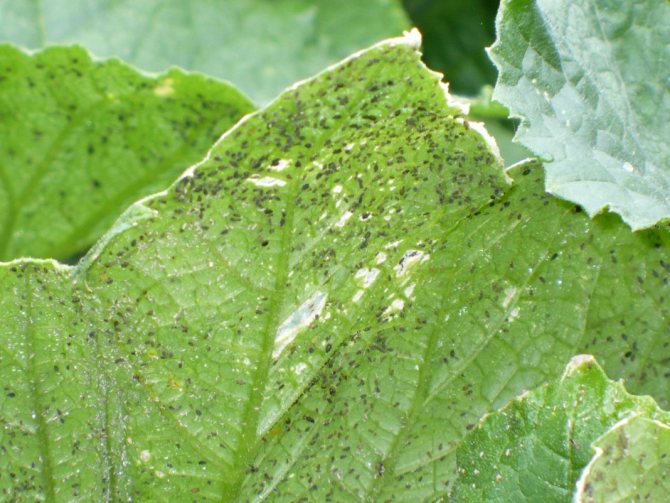

Aphid-infested cucumber leaves. <>
Why do the ovaries turn yellow
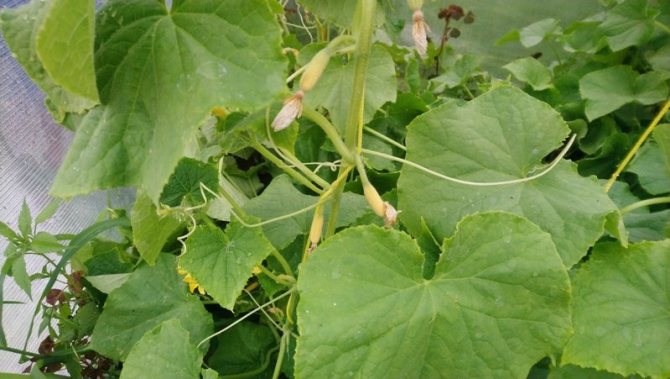

Yellowing of the ovaries
Ovary discoloration is most common in cultivars grown in greenhouses. There are several reasons for this:
- Pinching and formation of bushes were not carried out. The plant develops an excess of green mass. And, it turns out that sunlight simply does not reach the ovaries.
- Feature of the hybrid. High-yield varieties are not able to provide nutrition for all ovaries. Therefore, the plant gets rid of some of them. If a small part of the ovaries falls off, then there is nothing to worry about. This is a natural process.
- Pollination does not occur. Usually parthenocarpic hybrids of cucumbers are planted in greenhouses, but sometimes varieties that require pollination are also found.
- Violation of the irrigation regime and the feeding schedule. You need to apply fertilizer for cucumbers every 7 days. During flowering and fruiting, you need to feed with potassium-phosphorus preparations.
- Temperature changes. It is very hot in the greenhouse during the day, but at night the temperature can drop quite strongly. Because of this difference, cucumber ovaries may turn yellow. To prevent this from happening, close the greenhouse and greenhouse at night. In addition, temperature changes contribute to the appearance of a fungus, due to which the ovaries also turn yellow.
What to do?
Attract insect pollinators. Leave the greenhouse open for a day, sprinkle with sweet water.
In case of a lack of potassium, process the planting "Solution", "Kemiroi" or a solution of ash and calcium nitrate (3 tablespoons of ash + 10 g of nitrate per 10 liters of water).
To avoid overheating, mulch the soil under the cucumbers. This technique will also help combat root rot.
If the plant is sick, then treat it in a timely manner. "Fitosporin" and remember to pick and destroy damaged leaves. This will prevent further spread of the fungus.
Cucumber pest control drugs
Many gardeners and summer residents tend not to use chemicals on their site. Moreover, now there are many modern biological products on sale that can be used for pest control. Therefore, in the arsenal of gardeners there should also be biochemical preparations (fitoverm, acarin, agravertin). For example, Fitoverm Is a preparation of biological origin against pests, hemoparasites that damage vegetables, fruit trees, bushes, indoor and outdoor flowers. What "Fitoverm" helps to escape the best is from whiteflies, thrips, leafworms, moths and aphids. Fitoverm has some application features. Due to the rapid decomposition of the product under the influence of light, it is necessary to spray the plants at dusk. The number of treatments depends on the environmental conditions and the type of insect.
"Summer resident" - a natural preparation based on fir oil against sucking and gnawing pests (aphids, spider mites, whiteflies, thrips, strawberry mites, onion flies, cruciferous fleas, etc.), from garden ants and wireworms. The final treatment should be carried out 10 days before harvest.
Why do leaves turn yellow in the open field
Outdoor cucumbers are susceptible to many negative factors. It is quite difficult to determine why the leaves turn yellow. This can be due to hypothermia, exposure to direct sunlight, fungal infection, or lack of nutrients.
What to do?
First of all, follow the rules for caring for cucumbers.
- Water with warm water under the root. Water the cucumbers regularly. This is best done in the morning or evening.
- Cover plantings during temperature extremes. This will protect the plants from hypothermia.
- Carry out regular feeding and preventive treatment for diseases and pests. It is especially important to apply fertilizers during flowering and fruiting.
Causes of yellowing and wilting of the lower leaves of a cucumber
We figured out the reasons and methods for eliminating yellowing, wilting and drying of the main, large leaf plates of a cucumber, but the following picture is often observed: the main leaves look healthy, and the lower, smaller leaf plates of a cucumber suddenly begin to turn yellow and wither. Gardeners sound the alarm, not knowing the reasons for this phenomenon, but is it really so dangerous?
The most common reason for the yellowing of the lower leaf blades of a cucumber is lack of light... Located higher, more powerful leaf blades elementarily shade the lower leaves and they die off, being unclaimed.
In this case, you should not beat the alarm, you can simply remove the yellowed and starting to dry cucumber leaves, the plant simply does not need them.
The second reason is possible micronutrient deficienciessuch as magnesium or macronutrients such as potassium and phosphorus.
In this case, it is necessary to apply a complex mineral fertilizer containing microelements under the cucumber. The application rate is 12-15 g per square meter. Sometimes the introduction of wood ash helps, this is an excellent potash fertilizer containing trace elements too. Under each bush, after loosening and watering the soil, you need to add 50-100 g of wood ash.
The third reason is natural aging of the plant... If the lower leaves of the cucumber began to turn yellow towards the end of the season, then you should not worry, most likely they will die off, since the lowest leaf blades are older.
In this case, the same best option is to remove the leaves of the cucumber so that they do not start to rot.
If none of these methods helps, then check: whether the plants interfere with each other, perhaps they are placed too close and the leaf mass of some strongly shades those that are located nearby. If this is true, then you will have to take drastic measures - remove part of the cucumber lashes or even the entire plant.
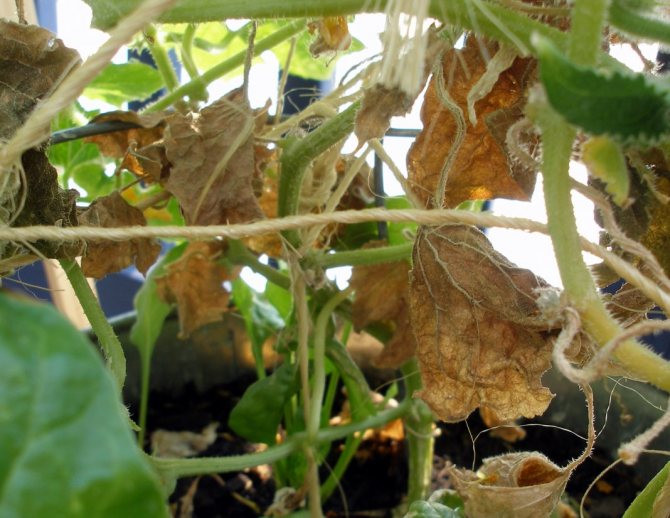

Drying of the lower leaves of a cucumber
Why do cucumber leaves turn yellow in a greenhouse
Most often, the leaves of cucumbers growing in greenhouses turn yellow due to improper care:
- The greenhouse is not ventilated.
- Bushes are not formed.
- The plantings are thickened.
All this in combination becomes the cause of yellowing of the foliage and decay of the lashes of the plant.
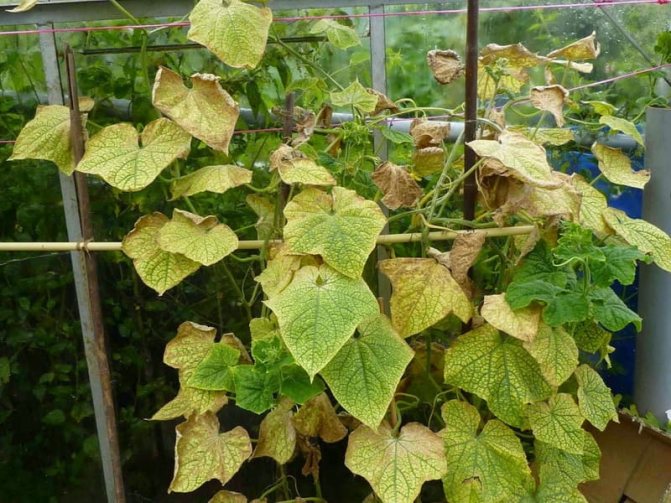

Yellowing of cucumber leaves in the greenhouse
What to do?
Airing and pinching are two important procedures that will protect your plantings from rot and the development of fungal diseases.
How to prevent diseases of cucumber leaves
1. These water procedures must be started at the initial stage of plant development, when the first four leaves have appeared on the young seedlings. And then repeat it three times a month.For a large ten-liter bucket of water, add 1 liter of milk, 30 drops of iodine and 20 grams of regular laundry soap. Use for spraying.
2. In a ten-liter bucket of water, leave a loaf of bread to soak overnight. After about 10-12 hours, the bread will be easily kneaded. Add a small bubble of iodine to this mixture. Spraying can be carried out 2 times a month throughout the summer season.
3. To prevent the appearance of fungal diseases, use a soda solution for watering - add 1 tablespoon of soda to a large bucket of water. Watering with this solution is carried out at the beginning of summer.
4. Universal solution that is suitable for watering and spraying:
With 10 liters of water, you need to pour about 100 grams of onion husks, boil and leave to infuse overnight under a closed lid. The strained broth must be diluted with water before use: 400 grams of water are added to 100 grams of solution. This solution will scare away harmful insects.
5. Solution for better formation of the ovary and from yellowing leaves: mix 2 liters of kefir or whey with 10 liters of water and an incomplete glass of granulated sugar. Use for spraying.
6. Pour the hay with warm water (in equal parts) and leave for 2 days to infuse. Use for spraying no more than 3 times a month. The infusion prolongs the fruiting period for the plant.
Leaves turn yellow and curl
First of all, take a close look at the back of the leaves. Make sure there are no pests. Leaf twisting is one of the main signs of the appearance of a spider mite.
Next, pay attention to whether the plant is affected by the fungus. If the leaves just turned yellow without gray or white spots, then there is no fungus.
What to do?
If signs of fungal disease or pests are found, plantings should be treated with fungicides and insecticides.
IMPORTANT! In case of fungal infection, the infected leaves must be torn off and burned.
Similar problems of cucumbers on the windowsill
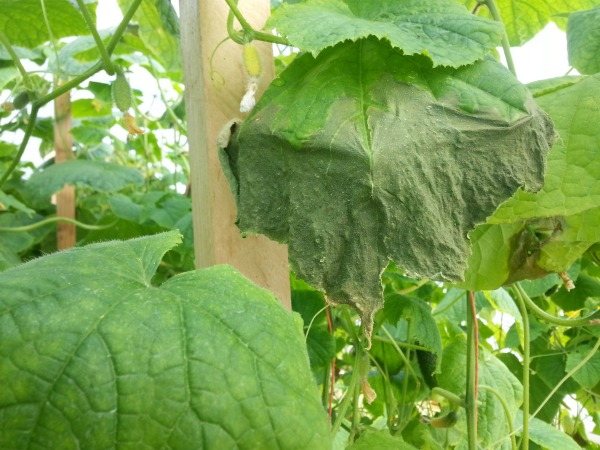

The foliage of young seedlings on the windowsills begins to wither and dry out after yellowing. Plants wither in front of their mistresses, who often just shrug their shoulders from not understanding what is happening.
Why leaves wither and dry
Cucumber leaves dry up on windowsills for several reasons:
- Depleted soil. Some housewives use soil taken from flower pots for seedlings. Such a soil is categorically not suitable for cucumbers. Also, there may simply be few nutrients in the soil. In any case, the seedlings are transplanted into a suitable land for her.
- For window cucumbers, it is quite difficult to create suitable climatic conditions. Even a window ajar for a while, in cold weather, can cause yellow leaves, their wilting.
- Seedlings grown from low-quality material will have poor performance. Bad seeds often do not germinate, and the seedlings that appear are very painful. It is better to carry out reseeding immediately.
- Indoor cucumbers are somewhat picky about neighbors. Some nearby plants can kill them.
Most often, yellowness is observed on the lower foliage. The reason is all kinds of stress:
- Low lighting;
- Wrong watering schedule;
- Hypothermia of plants;
- Elemental starvation of cucumbers;
- Fungal ailments;
- A sharp change in conditions;
- Maturity.
Why do they turn yellow at the edges
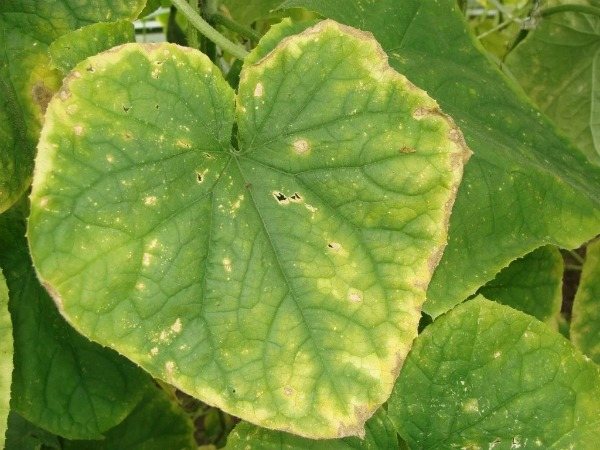

Crops often turn yellow when powdery mildew appears. After the appearance of white spots, the leaves along the contour are colored with a slight yellowness. Gradually, the foliage begins to dry out and fall off.
If measures are not taken in time, the bush will die completely. Topaz and Zaslon will come to the aid of the window cucumbers. The preparations are sprayed onto the cultures until fruit appears.
Also, the cause of the yellow border on the foliage of cucumbers is fusarium. A pathogenic fungal disease blocks the delivery of food through the capillaries.
Fusarium is so dangerous that even with timely treatment it is difficult to achieve a positive result, and most often the cucumber dies.
The yellowness that appears on the foliage often baffles even experienced vegetable growers. But for beginners, it is practically impossible to grow fresh greens on their windowsills.
The border of the leaf or its edges turns yellow
Yellowing of the leaf edge without the formation of yellow spots on the leaf blade itself indicates a lack of potassium.
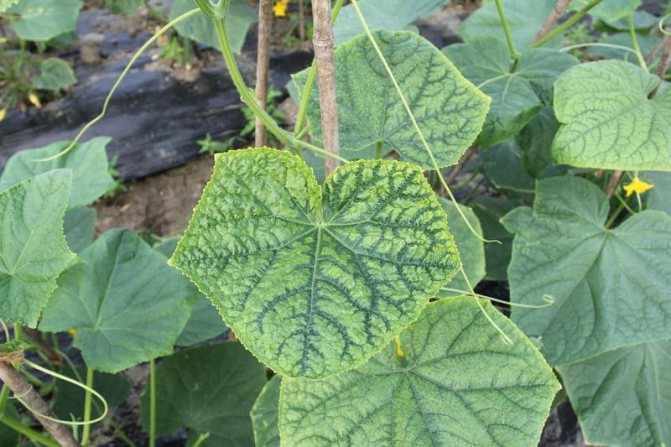

Yellowing due to micronutrient deficiencies
What to do?
Feed the plant with potash fertilizers. It is best to use liquid preparations with a complex of useful elements.
Lack of fertilizer
If there is enough moisture in the soil, and the leaves turn yellow, then the plants need to be fed. So, it is known that during the period of active growth, cucumbers must be fed with nitrogen fertilizers, if they are not available, then the leaves will begin to turn yellow.
At the beginning of the yellowing of the foliage, you can try to feed the cucumbers with ammonium nitrate, dissolving 25-30 g in a bucket of water. The consumption rate of such a solution is approximately 1.5-2 liters per square meter. It is advisable to feed the cucumbers 2-3 times, paying attention to the condition of the leaf blades. In the event that the yellowness of the leaves has not subsided, you can feed them with a solution of nitroammophoska by dissolving a tablespoon of this fertilizer in a bucket of water. Consumption rate - 3-4 liters per square meter of soil.
In the event that the cucumber leaves not only begin to turn yellow, but can still curl, then this most likely indicates a significant nitrogen deficiency in the soil. You can understand that this is precisely the lack of nitrogen by the direction of curling of the cucumber leaf blade, if it curls downwards, then this is definitely a nitrogen deficiency.
It is possible to compensate for a sharp nitrogen deficiency by introducing ammonium nitrate into the soil in an amount of 15-18 g per square meter, having previously dissolved it in water. You can treat the cucumber plants themselves with ammonium nitrate in the evening, dissolving 8-10 g of this fertilizer in a bucket of water. This will be foliar feeding, which can have a positive effect.
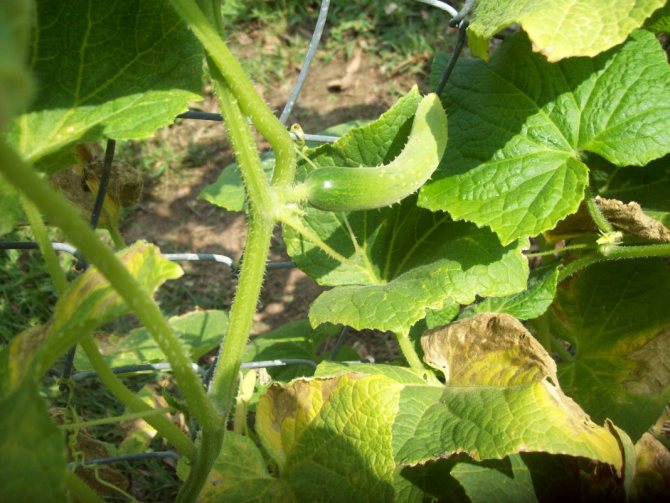

Yellowing of leaves due to lack of nitrogen. <>
Why do cucumber seedlings turn yellow
The reasons for the yellowing of seedlings are basically the same as in adult cucumbers. To them, you can add too tight containers for germination and high humidity in the room.
- Seedlings need space for the seedlings to develop sufficient roots for transplanting into open ground or a greenhouse. If too many plants germinate in one container, then due to crowding they will gradually begin to turn yellow.
- High humidity in the room causes the appearance of fungus.
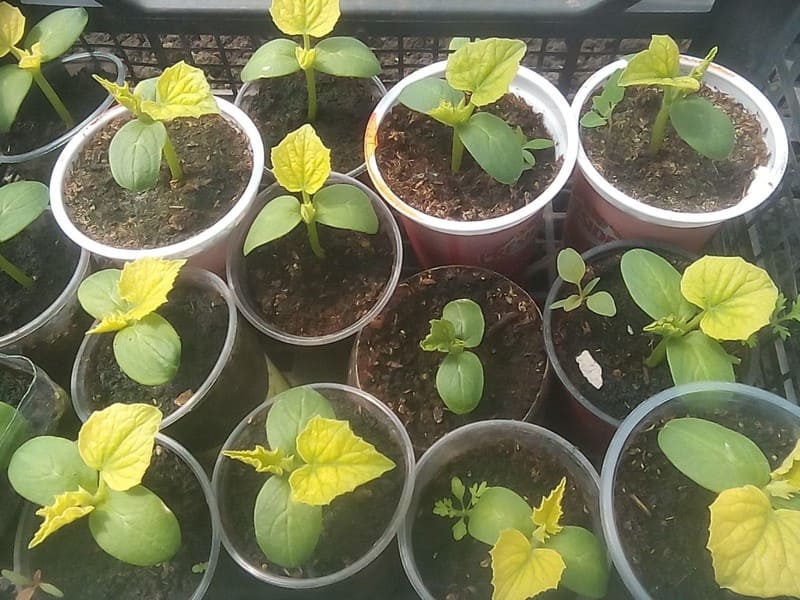

Yellowed cucumber seedlings
What to do?
If the seedlings are cramped, they need to be transplanted into larger containers. But still try to select the container of the right size in advance.
If the air humidity is high, ventilate the room regularly.
IMPORTANT! When airing, make sure that your cucumber seedlings are not in a draft. She can easily die from him.
Wrong mode of watering cucumbers
You need to water cucumbers so that there is enough moisture in the soil, but not an excess or deficiency. With a lack of moisture, the leaves of cucumbers are guaranteed to turn yellow, with an excess of moisture in the soil, in addition to the fact that the leaves will turn yellow, the plants themselves may begin to rot. Ideally, the soil should be moderately moist to a depth of about 9-12 cm.
What should be done if cucumber leaves in a greenhouse or open field suddenly start to change color? First of all, you need to immediately normalize watering, establish whether the soil is sufficiently moistened, whether it is overdried or waterlogged. This can be easily verified by excavating the soil to a depth of 9-11 cm.The optimal greenhouse watering regime is a bucket of water per square meter every two or three days. It is clear that if it is hot, then the rate of watering for cucumbers can be doubled, and if it is damp and cloudy, then it can be halved.
If the soil under the cucumbers is too moistened, then it is imperative to stop watering and loosen the soil on the entire surface. It is also allowed to scatter dry river sand or wood ash over the surface, they will absorb some of the moisture.
In the event that the soil under the cucumbers is dry, then it must be well shed. Only room temperature water should be used to moisten the soil, and in order for the moisture to penetrate deeper into the soil, it is advisable to loosen it before watering. After watering, the soil should be mulched with humus with a layer of 1 centimeter.
Anti-yellowing folk remedies
You can fight the yellowing of the leaves of cucumbers with folk remedies without chemistry.
If the reason for yellowing is a lack of nutrients, then use the following infusion.
Take 300 g of sifted ash, 200 g of dry mullein, mix and pour a bucket of water. Everything must be thoroughly mixed until a homogeneous consistency and left to infuse for 24 hours. Top dressing should be done at the rate of 1 liter of solution per 1 cucumber bush. The frequency of processing is 1 time in 7 days.
If the reason for the yellowing of the leaves is a fungal infection or aphid infestation, then use the following recipe.
Wash the affected leaves with a mild soapy solution of laundry soap. Then sprinkle the affected areas with ash. Such processing should be carried out until the bush is completely healed at an interval of 3 days.
Another, more powerful tool is prepared from natural soda. 1 tbsp. the spoon must be diluted in 5 liters of water. Plants are treated with a spray bottle. This tool should be used very carefully and only in case of severe infection. Do not under any circumstances exceed the indicated dosage. Otherwise, you will simply "burn" the leaves.
Tar against pests
Birch tar belongs to folk remedies.
Tar is a distillation product of the outer part of birch bark. It is widely used in medicine, as well as in the garden. Birch tar is effective against fungal disease
Tar is especially effective against the following pests:
- Sprout fly, pest of cucumbers and pumpkin seeds
- Colorado beetle
- Against carrot fly and carrot
- Onion fly.
- Cruciferous plants are damaged by cabbage fly and white butterfly
- Radish, turnip and other root vegetables
How are drugs treated?
If folk remedies do not help, then use specialized drugs.
The most effective remedies for yellowing leaves in cucumbers are "Metronidazole" and Fitosporin... Both drugs must be sprayed onto the plant. The proportions for the preparation of the composition are indicated on the packages. We advise you to follow the instructions so as not to harm the cucumbers even more.
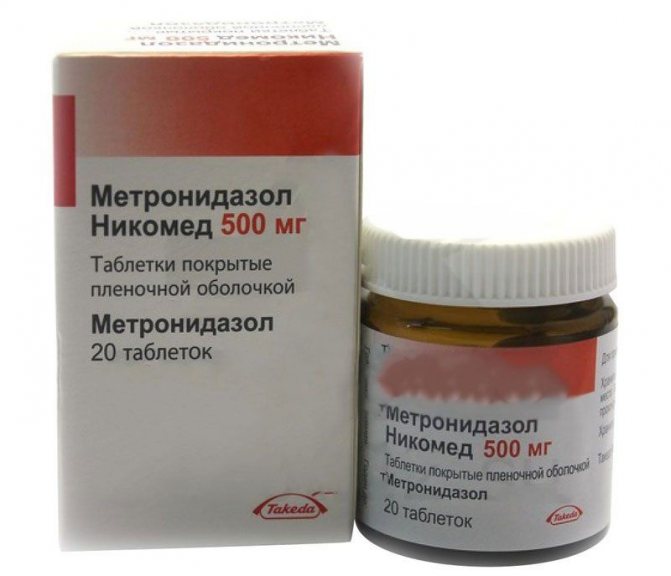

Metronidazole
If the yellowing has just begun, then you can try to save the planting with potassium permanganate. To do this, you need to prepare a 1% solution and spray the affected leaves with it.
If you are sure that the reason for yellowing is a lack of nutrients, feed the bushes with complex nitrogen-phosphorus-potassium fertilizer.
Burning sun
Usually, cucumber leaves are not harmed by the sun itself, but in combination with other factors. Often we ourselves are to blame, and the sun only aggravates. For example, if we water cucumber plants in the heat, then the moisture accumulated on the leaf plates acts like a lens: rays pass through it and burn the leaf tissue. The second option is when a fine short-term rain falls, which leaves tiny drops on the leaf blades, and after the sun comes out from behind the clouds they literally boil and evaporate from the surface of the cucumber leaf, leaving burns.
There is only one way out - do not water the plants in the heat on the leaves, watering is better done in the morning and evening hours, and in the morning you need to try not to get on the leaf blades when watering. In the greenhouse, in order not to accumulate condensate that rains on cucumber leaves, you need to open the vents in order to reduce air humidity and temperature and prevent its appearance.
Prophylaxis
In order to prevent yellowing of the leaves, it is recommended to carry out preventive treatments for plantings of cucumbers.
Solutions based on milk and rye bread are considered the most effective.
Milk solution treatment
This product protects cucumbers from the appearance of pests and fungi.
The composition is prepared as follows: in 8 liters of water it is necessary to dissolve 0.5 liters of milk (preferably 2%), 20 g of laundry soap and 20 drops of iodine.
Carry out processing at intervals of 10 days.
Processing with a solution on rye bread
The tool helps against pests and plays the role of additional foliar feeding.
The composition is prepared as follows: 500 g of rye bread is soaked in a bucket of water for 12 hours. Then the soggy crumb must be rubbed until it turns into a thick homogeneous mass. After that, 40 drops of iodine are added. The composition is mixed again until a homogeneous consistency. Next, the resulting thick liquid must be filtered in order to separate the remaining bread from the liquid.
Treatment with the resulting solution should be carried out every 2 weeks.
Folk ways to keep cucumber leaves healthy
The use of chemical compounds helps to avoid yellowing of the foliage. But not all amateur gardeners who grow cucumbers on windowsills accept such means. A way to solve the problem is to use folk recipes.
Deciduous yellowness is successfully prevented with a solution made from kefir or milk whey. Nutrient fluids are diluted with water in a ratio of 2:10. The resulting composition is regularly sprayed with cucumbers.
Mullein infusion is used as an effective top dressing. A kilogram of dung diluted in three liters of water should be infused for three days. Then the mixture is filtered and again diluted with water.
This composition is suitable for spraying cucumbers. The prepared product is an excellent weapon against powdery mildew and serves as a foliar feeding.
Why does the ovary dry up?
Yellowing of the lower leaf plates is not so bad. If the ovary and upper leaves turn yellow, it's time to sound the alarm.
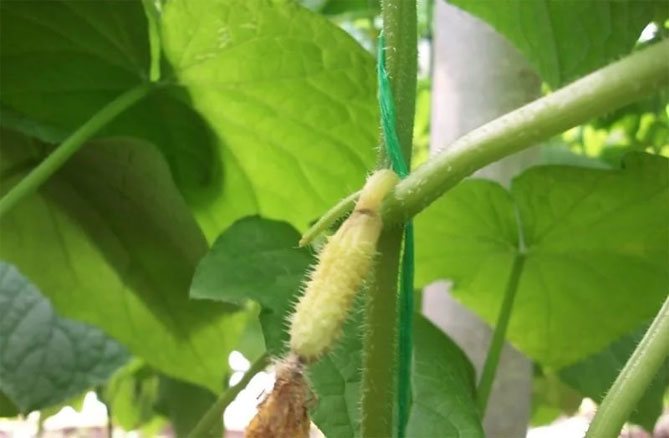

The main reasons for the yellowing of the ovary are as follows:
- insufficient solar illumination of the upper tier of the plant;
- exposure to low temperatures on the bushes;
- lack of nitrogen, potassium in the soil.
Attention! It is very important for cucumbers to withstand temperature conditions.
Table. Optimum temperatures for growing cucumbers
| Growing period | Temperature, degrees С | |
| before fruiting | in the afternoon | 21-24 |
| at night | 18 | |
| after entering fruiting | in the afternoon | 23-27 |
| at night | 19 | |
Cucumbers dry and turn yellow solution to the problem with home remedies, recipes
Drying of the green cover, coupled with the appearance of yellow spots, is a sign of fungal infection. Most of the dressings described above can not only improve the development of the growth, but also preserve its health. Let's supplement the list with recipes for combating plant ailments.
Milk-soap composition
The solution is prepared from a bucket of water, a liter of milk or yogurt, a tablespoon of grated laundry soap and 30 drops of iodine tincture. Add soap last and make sure it dissolves completely. The frequency of preventive treatment is 10 days. Spraying is carried out after the appearance of 4-5 leaves.
Serum
You can use the recipe described above to overcome late blight and powdery mildew, or you can simply dissolve 2 liters of whey in a bucket of water. Such spraying will not bring harm even with daily use.For the prevention of late blight in the greenhouse and in the open field, it is recommended to carry out processing every 5-6 days, so as not to provoke high humidity.
Soda
Every home has baking soda, so making a composition to kill fungal spores is easy. Dissolve a tablespoon of vegetable oil and soda in 5 liters of warm water, add an aspirin tablet and mix thoroughly. To prevent the bush from getting burns, process it only in the absence of the sun. For watering, dissolve a tablespoon of baking soda in a bucket of water.
Potassium permanganate
Finding signs of disease, move 1% solution of potassium permanganate. Spray the bushes with the compound.
Attention! Make sure that all potassium permanganate crystals are completely dissolved in water. The smallest particles can cause severe burns.
Infusion of garlic
Garlic infusion effectively fights all diseases and pests of the culture. To do it take:
- water - 1 liter;
- chopped garlic - liter jar;
- liquid soap.
Mix the ingredients, keep in a dark place for 10 days. Strain and take 1-3 tablespoons per 10 liters of water. Pour in some liquid soap for better adhesion. The product is effective until the first rain. Re-spray if necessary.
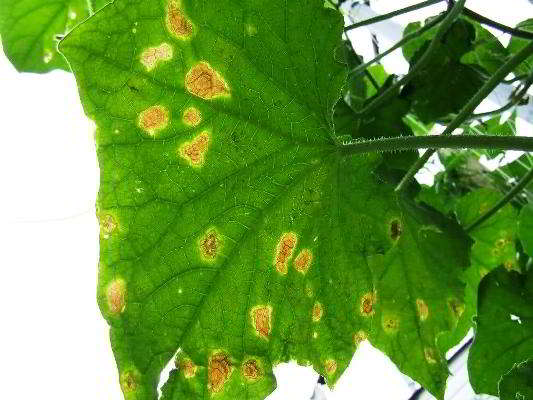

Mullein infusion
Cow dung is used for more than just raising nitrogen levels in the soil. It is effective against powdery mildew. Add a three-liter can of water to 1 kg of cow dung. Leave the composition for 3 days, strain and dilute in 3 parts water before spraying.
Treatment of peronosporosis with brilliant green
A remedy made from 10 liters of water, 50 g of carbamide, 2 liters of whey and a bottle of greens (10 ml) will help to cure downy mildew. Spray the mixture over the leaves three times a month.
Trichopolum for powdery mildew
The antibiotic Trichopolum effectively destroys spores and mycelium of the fungus. It can be applied in different ways. When planting, the tablet placed in the hole will disinfect the soil. To cure foliage in a liter jar, dissolve 2 Trichopolum tablets. You can etch the soil with a bucket of water with five tablets of the drug.
Know! Trichopolum can be replaced with metronidazole.
What temperature to keep in a greenhouse for cucumbers
If the temperature in the open field cannot be regulated, then in greenhouse conditions it is quite possible.
If, for some reason, the temperature differences in the greenhouse are quite large: hot during the day and cold at night, then for cucumbers this is stress. This condition is expressed in the yellowing of the leaves. Cucumbers are thermophilic and do not tolerate low temperatures.
The optimal temperature regime in the greenhouse for growing cucumbers is as follows:
- Daytime temperature + 23-25 ° C;
- Night temperature + 17-19оС.
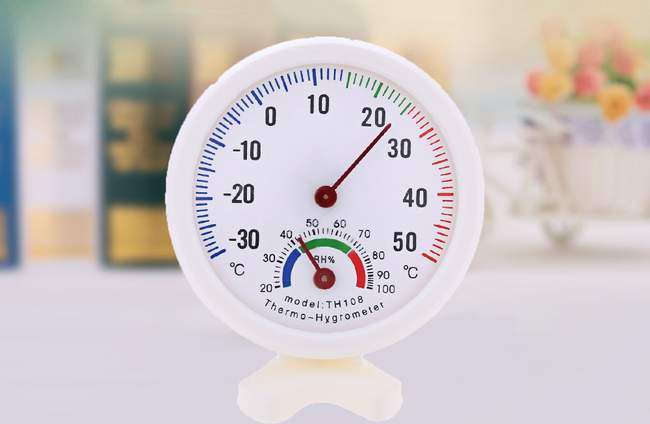

Try to maintain optimal temperature when growing cucumbers
To ensure smooth temperature transitions, we recommend using polycarbonate when building greenhouses, and turn on the heating at night if necessary.
What should be the soil for cucumbers
The condition of the soil in which cucumbers are planted for comfortable growth plays an important role. The soil should be fertile and well loosened. Cucumbers do not tolerate acidic soils well; after measuring the indicators, lime can be added. It is also important to consider that it is impossible to plant a crop in the same place for more than five years, as the risk of contracting diseases increases.
An important point is the correct crop rotation: cucumbers can be planted after potatoes, tomatoes, peas.
Before planting, you can fertilize the soil by adding humus, wood ash, eggshells a week before planting.
Cucumber disease treatment
Fungal diseases of cucumbers are treated with insecticides.
- With fusarium, plants are treated with Fundazol. The whole plant is sprayed, and the soil around the roots is watered.
- Powdery mildew is treated with fungicides.You can also try the folk method: hot water, crushed soap and soda (for 5 liters of water, 25 g of powders). Spray the plant with the cooled solution and water the soil around the roots. Quite good reviews in the use of Bordeaux mixture.
- Anthracnose - Use fungicides such as Previkur. It is also recommended to use Bordeaux mixture, colloidal sulfur, crushed coal. Anthractosis is a common disease in the garden, we recently touched on this topic in an article on strawberry diseases.
How to treat cucumbers from pests
To treat cucumbers in case of damage by pests, the best way to control would be to use a wide range of insecticides: for example, Confidor.
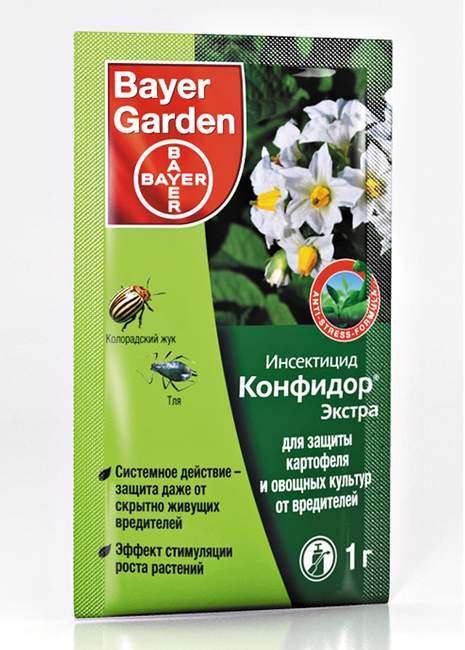

From folk methods we can recommend onion-garlic infusion.
A solution of nitroammofoska helps well with aphids: dissolve two tablespoons of powder in a bucket of water and process the leaves from the bottom side.
What to do if cucumber leaves turn yellow
Having found the cause of the yellowing of the leaf blades, you can begin to eliminate it. The tips below will help keep your green ward healthy. To replenish the deficiency of nutrients, it is necessary to make additional feeding. Try to rely on the needs of the bush based on the symptoms described above.
Advice! The introduction of a full mineral complex is able to satisfy the plant's needs for macro and microelements.
Fungal diseases occur due to a violation of agricultural technology. In particular, sharp fluctuations in the background temperature and humidity activate the processes of mycelium growth. Compliance with agrotechnical rules will help protect the growth from fungi. At the first signs of mycelium development (the appearance of spots), take urgent measures to treat it with fungicides or folk remedies.
There is no defense against a virus attack, only preventive measures can preserve culture. Observe strict crop rotation, pickle soil, seeds, remove plant residues. Noticing the active activity of pests, treat with appropriate preparations.
Protect the bushes from overheating and hypothermia. Cover the planting with foil when the temperature drops. Make sure that the leaves do not come into contact with the cold glass of the greenhouse or window (when growing by seedlings).
Attention! Make sure the foliage is completely dry after watering, as the remaining droplets in the sun will begin to evaporate, causing burns.
Excessive moisture leads to root rot. Root rot is caused by a fungus, so take steps to eliminate it. Replenish the lack of moisture with regular abundant irrigation. With proper watering, the soil should be moistened to a depth of 10 cm. To avoid rapid evaporation of moisture, use mulch - peat chips, humus, sawdust. Exot is extremely sensitive to a lack of light, so place the garden in the most illuminated place. When growing seedlings, an additional light source is required. Use a special device - phytolamp or cold glow lamps.
The plant can get trauma to the roots in the process of transplanting, hilling, loosening. Be careful when conducting these activities. Another factor that can injure delicate roots is a bear. The pest feeds on root crops, but digs holes throughout the site. Pour some vegetable oil, soap solution into the holes. You can lure the bear using a beer trap or rotten carrots. The bait is placed in the hole, the beer in the bottle is dropped at an angle. Check the trap periodically and eliminate the pests.
On a note! The traps described above can attract not only the bear. The slugs will happily drown in the intoxicating embrace, and the wireworm will creep in to feast on root crops.
Pests that lead to yellowing of leaves
Often, the leaves on cucumbers become yellow due to the activity of pests.Usually, the latter simply suck out useful substances from the cucumber for their own nutrition. The most common pests are:
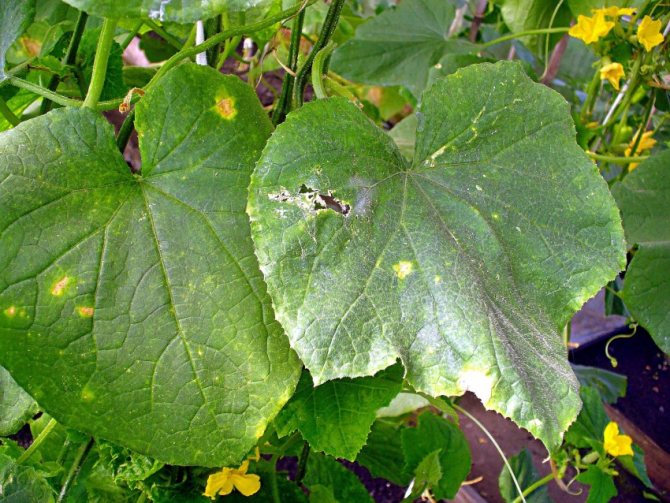

Whitefly. A small butterfly, the body of which is only 1.5-3 mm long. It develops especially actively at high ambient temperatures and high humidity.
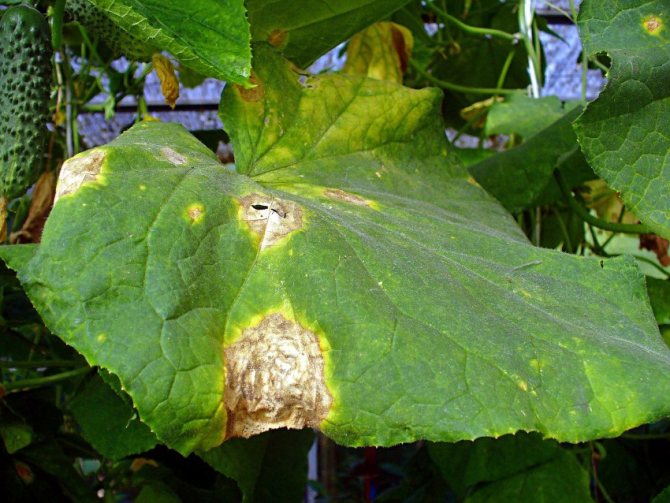

Aphid. Small soft-bodied insect in light green color. Despite its small size, it destroys very large volumes of cucumbers and multiplies extremely actively.
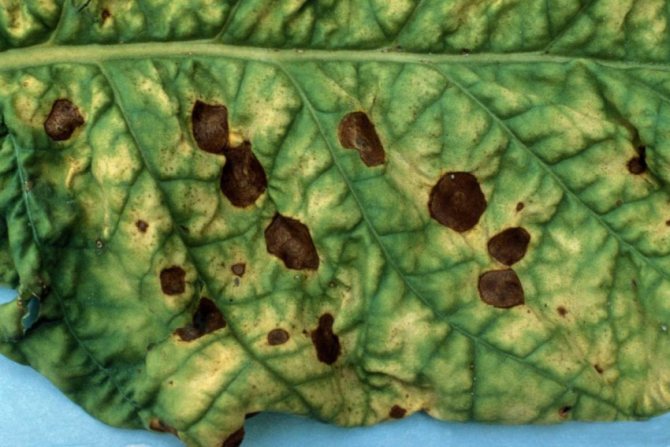

Spider mite. It is not easy to notice such a pest, its dimensions are less than 1 mm. The insect has a circular shape and sparse bristles. It usually lives on the back of leaves, it can also hide and move under earthen lumps. Poorly tolerates high levels of humidity.
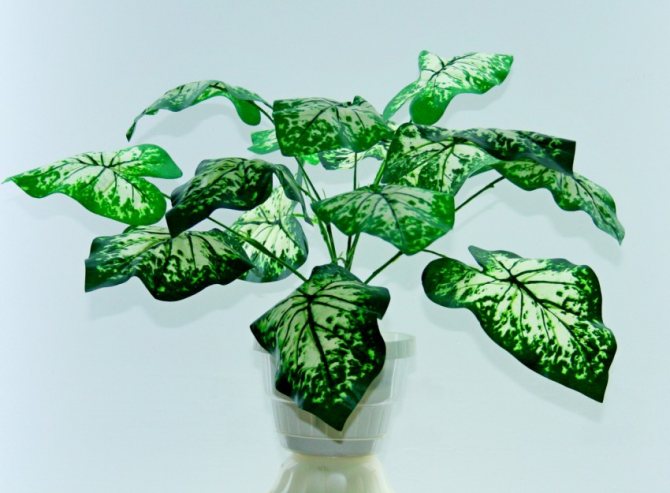

Dieffenbachia - home care tips. How to properly maintain and use a plant in interior design (125 photos and videos)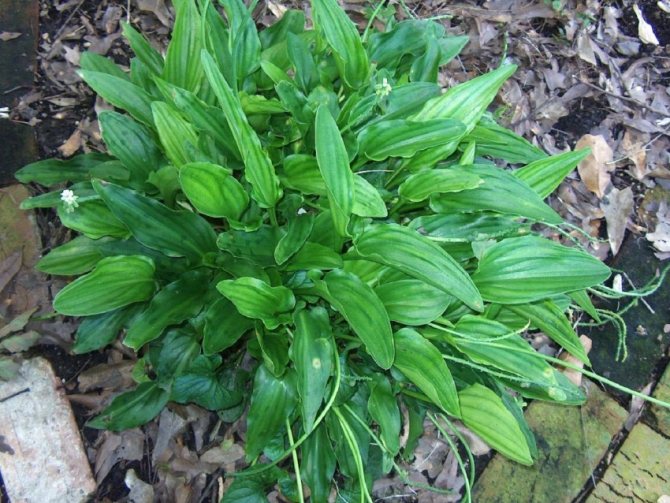

Drimiopsis - photos, videos and home care methods. Growing an ornamental plant with your own hands (110 photos)
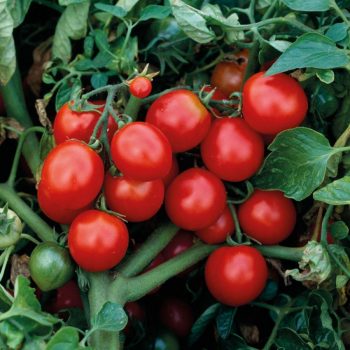

Fitosporin for tomatoes: methods, processing methods, video instructions and 105 photos of the result of application
Photo tips how to process cucumbers so that the leaves do not turn yellow
Influence of external conditions
Violation of vegetative development can occur due to: low lighting, sunburn, a small amount of water or nutrients, a sharp change in temperature, too rapid cooling of air and soil, infection with diseases or damage by all kinds of insects.
Yellow spots have their own characteristics. To determine the exact cause of their occurrence, it is necessary to carefully examine the stain, the damage is different:
- location;
- shades;
- edging spots;
- additional symptoms of plant disease.
Based on the signs of yellowing, it is necessary to choose the right measures to eliminate them, in different cases they will be different.
Hypothermia
Cucumbers react very quickly to changes in air temperatures, if the day before it dropped quickly or there were heavy rains, then yellow lesions will appear on the bushes. The reason is that when the temperature drops, the plants do not assimilate the nutrient components, so the growing season is poor.
Normalization of the temperature regime will lead to the return of the healthy color of the cucumber leaves. Pay attention to weather forecasts, if frost or rain portends, then cover the plants with a non-woven cloth, it allows air to pass through and prevents the bushes from freezing.
Lack of light
The lack of sunlight occurs at different periods of cultural development. Often it is observed at the time of growing sprouts and directly during fruiting.
If the leaves began to turn yellow during the cultivation of seedlings, then the reason is an unfortunate location or cloudy weather. Photosynthesis slows down, and cucumbers no longer receive a sufficient amount of useful components. The problem is solved very easily - transfer the seedlings to a lighted place or use phytolamps as a light source.
Having built up a sufficient green mass, the plants begin to shade, so the leaves located at the bottom of the stem do not receive the normal amount of light and turn yellow. This process is inevitable; in this case, you can simply cut off the yellow pieces of the cucumber and cut off the whips that do not bring a crop. Such an event will help to partially extend the growing season.
Sunburn
If yellow lesions with a clear edging appeared on the plants, and before that you carried out watering on a sunny day, then the cause is a burn. The phenomenon will not bring harm, but you must remember that watering should be done in the morning or in the evening.
Watering cucumbers under the scorching sun is prohibited.
Is yellowing dangerous spots?
If the leaves of the cucumbers are covered with yellow spots, this is a consequence of the defeat of the bush by a fungal infection. Similar symptoms may indicate the following diseases:
- Anthracnose... On cucumber leaves, brown-yellow rounded spots appear, with blurry edges. Later, concave ulcers of an elongated shape appear on the stems.
- LMR (peronosporosis)... As a result of the defeat of cucumber bushes with downy mildew, rounded yellow spots appear on the leaves from above. And on the underside of the plate, fungal hyphae appear in the form of white thin threads.
- Sunburn... Yellow spots on the upper side of leaves can occur from sunburn. This especially happens when sprinkler irrigation is carried out at high solar activity.
Important! To eliminate the ailment in the first two cases, fungicidal preparations should be applied, in the latter - to transfer the watering time to the morning.
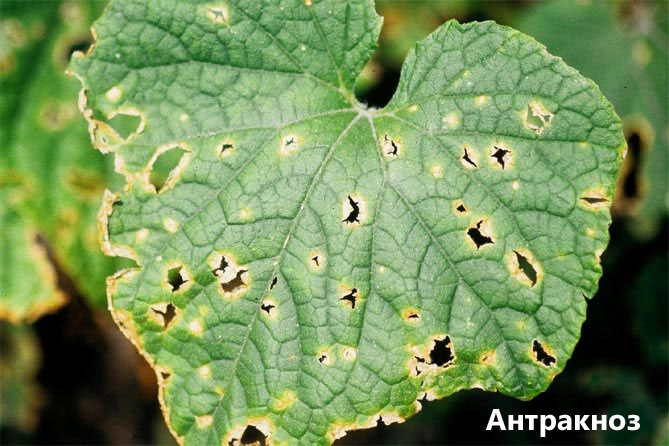

Varieties of yellowing
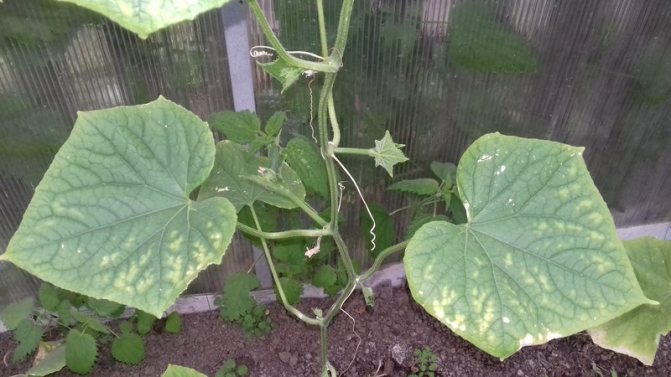

The leaves themselves will tell you about the deficiency of nutrients. If the plate has turned pale and acquired a yellowish tint, nitrogen deficiency is possible. Gradually, such a leaf will begin to roll the edges down.
Leaves turn yellow and curl
With a lack of calcium, the plates curl and die off. Twisting is also typical for plants affected by pests or fungal diseases.
On a note. Rolling leaves can also indicate a lack of nitrogen.
The lower leaves turn yellow
If the lower leaves of the bushes have gradually turned yellow, do not worry. The foliage of cucumbers is dense, so the lower leaves may simply not have enough sunlight. Yellowing and falling off in this case is a normal physiological process of getting rid of excess foliage.
Simultaneous yellowing of leaves and ovary
The most dangerous thing in growing cucumbers is the simultaneous wilting of leaves and ovaries. Measures must be taken immediately, otherwise the harvest may not be at all.
Main reasons:
- lack of sunlight;
- starvation - a lack of nitrogen and potassium, which are easily washed out of the soil with regular abundant watering;
- hypothermia of the bushes.
To solve the problem, feed young bushes with complex fertilizer and cover the beds at night, as well as on cool windy days.
The edges of the leaves turn yellow
At the edges of the leaf, cucumbers darken due to lack of nutrients, mainly potassium. If a border appears on the bushes, which has a characteristic greenish-yellow color, apply a complex mineral fertilizer or feed the cucumbers with an infusion of wood ash.
Leaves turn yellow spots
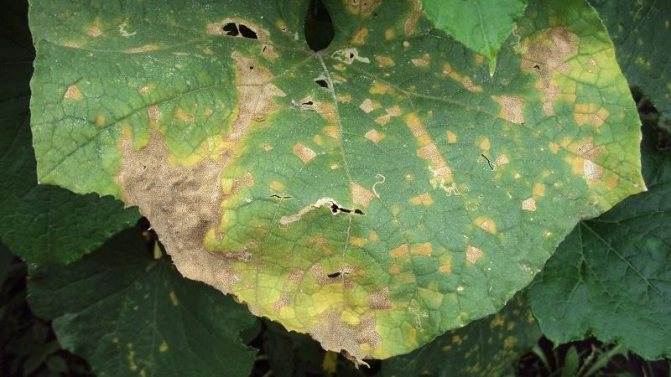

Most often, this indicates infection with late blight or some other fungal disease. The leaves turn unevenly and when pests appear that bite through the leaf tissue - it is at the puncture site that the first brownish-yellow spot is formed.
Also, a spotted color may indicate a deficiency of specific trace elements:
- with a lack of potassium, spots appear that resemble a sunburn;
- with a lack of magnesium, the spots are yellow-green, gradually spreading to the entire leaf.
If you do not add top dressing, then the plates will continue to dry out and die.
What to do and what folk remedies to process cucumbers
To decide what to do, you need to identify the reason for this state of the bush. It is necessary to resort to treatments in the following cases.
- Nitrogen deficiency. It is necessary to spray with a solution of urea (1 tsp for 5 liters of water).
- Phosphorus deficiency. Spraying is carried out once with superphosphate infusion (1 teaspoon of the product per 10 liters of water, leave for 24 hours).
- Potassium deficiency. The tops should be treated with potassium sulfate (1 tsp substance per 10 liters of water).
- Fungal diseases. The affected parts must be removed. Further, treatment is carried out with any systemic fungicide. Bordeaux liquid, which is popular among agronomists, would be an excellent option.
- Pests. Insects are removed with a sponge with soapy water, leaves with lesions are cut off. Following this, they resort to the use of an insecticide, for example, Actellik.
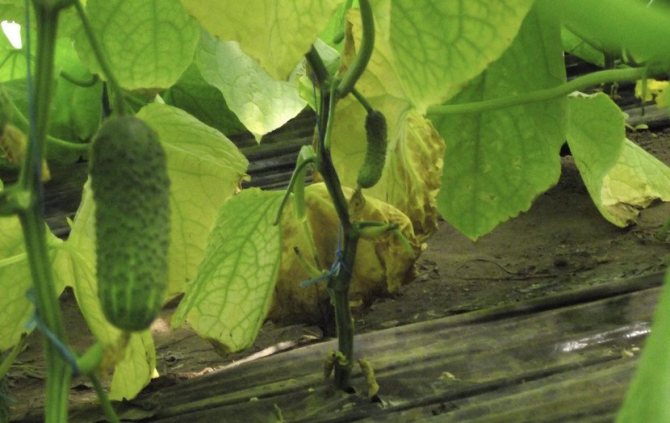

There are also several folk remedies with which the plant is treated when the first symptoms of yellowing appear.
- Kefir solution. Add 2 liters of kefir to 10 liters of water and spray the bushes with this agent. Kefir can be replaced with whey.
- Onion infusion. 1 cup of onion peel is infused in 3 liters of water for 12 hours. Next, you need to drain the liquid and squeeze out the husk. 1 part of this concentrate is mixed with 4 parts of water. This tool is used to spray the tops and water the soil.
- Ash infusion. Within 48 hours, you need to infuse a mixture of 1 liter of water and 3 tbsp. l. ash. The product is applied once by spraying.
Find out what to do if the cucumber leaves are yellow spots.
If the cause was improper care, the approach to plant growing should be changed:
- moderate or increase watering;
- heat water for irrigation;
- raise the temperature to + 20 ... + 24 ° С in the greenhouse;
- increase humidity up to 75–90%;
- adjust the lighting and provide bright indirect light.
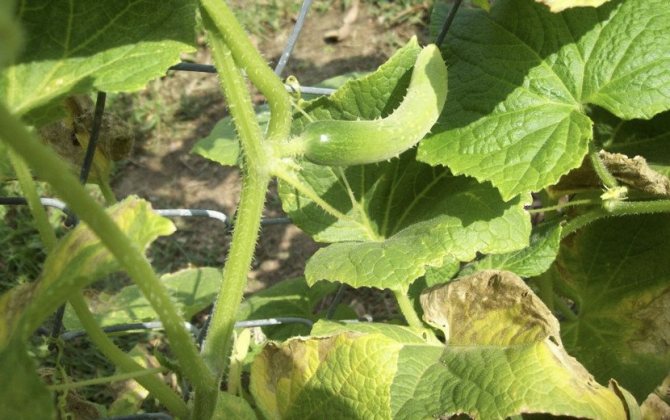

After diagnosing a viral lesion, it is necessary to remove the affected areas as soon as possible. If most of them are sick, the plants are uprooted.
Important! Vegetables must not be planted at the place of growth of cucumbers affected by the mosaic for 4 years.
Optimal conditions for growing cucumbers
First of all, plants need to create the necessary conditions for growth and development, otherwise the vegetables may show signs of disruption of care or beginning diseases.
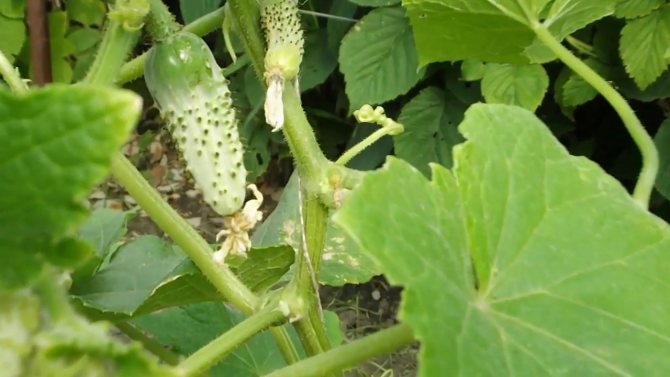

Open field cucumbers
In the open field
After planting seeds in open ground (or when planting seedlings in beds), you need to provide them with some care.
Important! The main thing is to observe the watering regime. If these plants do not have enough moisture, they will begin to dry out. If the soil moisture is too high, the roots of cucumbers may begin to rot or fungal diseases will begin. It is also necessary to make the necessary fertilizing on time, otherwise the plants may show signs of a lack of some macro- and microelements.
In greenhouses
Greenhouse plants can suffer from excessive humidity at high temperatures. In such conditions, most often plants are affected by fungal diseases, which will be difficult to get rid of.
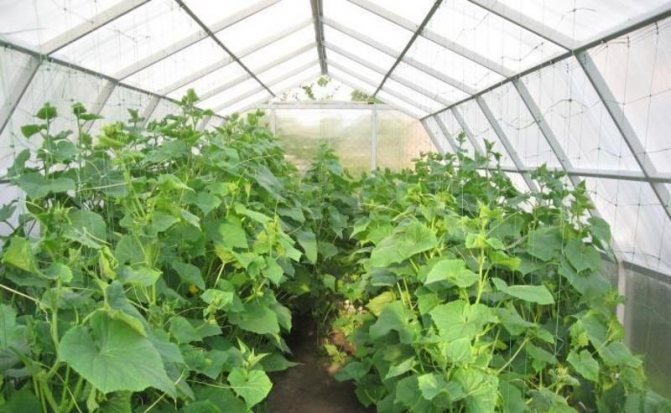

Cucumbers in the greenhouse
It is necessary to ensure that watering is regular, but not excessive. Otherwise, excess moisture will settle on the walls of the greenhouse (especially if the air temperature is high).
Note! It is in such conditions that fungal spores usually develop, which will cause the development of fungal diseases.
To avoid the development of fungal diseases or decay of the root system of cucumbers, you need to water the cucumbers in the first half of the day so that moisture can be absorbed into the soil during the day, and also to ventilate the greenhouse during the day.
Houses on the balcony
When growing cucumbers at home on the balcony, you must also observe the temperature regime, a certain humidity in the room. In addition, at home, cucumbers grow in small containers, so nutrients from the soil are quickly drawn out by plants. In such conditions, vegetables need to be fed more often than in greenhouses or in the garden beds.
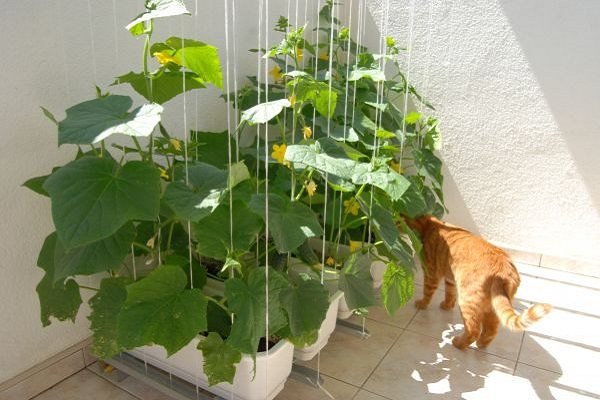

Growing cucumbers at home on the balcony
Balcony plants need sunlight, but not direct sunlight, which can burn cucumber leaves and stems. Ideally, if the balcony where the cucumbers grow faces the southeast or southwest sides. If the balcony faces south, at lunchtime you need to shade the plants from the hot sun.
Important! With the correct application of moisture, the soil should be moderately moist at a depth of 8-9 cm.
Features of agricultural technology
Agrotechnics are systematic measures aimed at obtaining a high yield. Sometimes non-observance of at least one point leads to the appearance of yellow lesions on the bushes.
Insufficient pollination
The main reason for the yellowness is insufficient pollination of already flowering cucumbers. This may be due to the fact that only self-pollinated bushes were planted.Due to the absence of insects, pollination of the bushes does not occur.
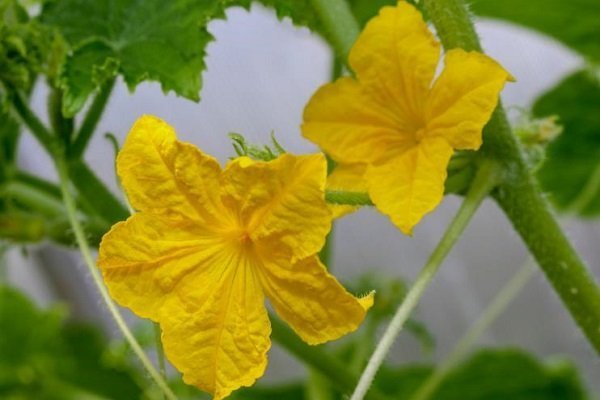

In this case, use the means "Bud" or "Ovary". There is also a folk remedy for attracting insects and restoring pollination: spraying with special "tasty" water (1 tablespoon of granulated sugar or honey per 2 liters of water). Next year, do not make such a mistake and plant seedlings next to the cucumbers that attract insects.
Congestion with ovaries
No more than 25 ovaries should be left on 1 bush. The reason for this is the too rapid development of the bush, the ovaries are rapidly gaining mass and growth. Many cucumber hybrids are capable of forming about 150 ovaries on 1 bush, but they will all be small and twisted.
It is necessary to pinch the shoots in time to give them a chance to fully ripen. Otherwise, excess shoots and ovaries lead to deformation of the fruit and the appearance of yellow lesions.
Improper watering
Cucumbers are a moisture-loving culture. The reason for their yellowing and drying is a lack of moisture and excessive scorching sun. On plants, the tips dry first, and then the entire leaf. To solve the problem, it is necessary to regulate competent and regular watering.
Spraying the plants is also beneficial, but remember that too much water can negatively affect the development of the bushes.
Read about the rules and methods for watering cucumbers in the next article.
Root damage
Moles, mice, shrews and other pests can damage the root system of not only cucumbers, but also other crops growing in your area. Do not forget about the correct loosening of the soil, do not deepen too much, otherwise you yourself will damage the root system of the plants.
Violation of the microclimate in the root part of the culture is the source of the appearance of yellow spots on plants.
Aging leaves
Yellowing of foliage in adult plants is a normal phenomenon, there is no point in fighting this. The bushes have already fulfilled all their purposes, now they are drying out, and they should be removed from the site.
Lack of fertilizer
A small amount of nutrients in the soil can cause yellowing of plant foliage. Often this culture thus shows a lack of nitrogen. A lack of fertilizer starts with the leaves becoming lighter and then turning yellow. As a result of a lack of nutrients, all the lashes on the cucumbers turn yellow, the fruits grow in the form of hooks.
Lack of nitrogen causes a large amount of wood ash and potassium dressings in the soil. To avoid this, you need to feed the seedlings of this culture a couple of days before transplanting into open soil with nitrogen fertilizers. During digging in spring and autumn, rotted manure is brought into the ground (1-2 buckets per 1 sq. M). Thus, there will be no shortage of nitrogen.
If during the transplantation of shoots, nutrients were not introduced into the soil, then during the growing season, feed the culture with chicken droppings or mullein. Also use an infusion called herbal tea.
You can save the culture by introducing mineral fertilizers, which contain nitrogen. Also, the leaves can turn yellow due to the huge amount of mineral dressings. Before putting them into the ground, read the instructions carefully. Read about how to properly feed cucumbers in the open field in the next article.
You will learn about the reasons for the appearance of yellowed leaves on cucumbers from the following video:
The scheme for processing cucumbers from yellow leaves
Most farmers treat diseased plants according to the order developed by many years of practice:
- determine and eliminate the cause that caused the change in the color of the leaves;
- choose the tool most suitable for eliminating the consequences of the impact of an unfavorable factor;
- free plants from yellowed leaves;
- prepare a working solution (chemical - according to the instructions, folk - according to the recipe);
- spray all parts of the plants with the agent, if necessary, water the soil around the cucumbers.
Do not forget about dressings for cucumbers, selected taking into account the type of soil, variety and appearance of plants. Many farmers add brilliant green to nutrient solutions (observing the recommended dosage). This makes up for the lack of copper in the "menu" of cucumbers, especially if they grow on swampy soils.
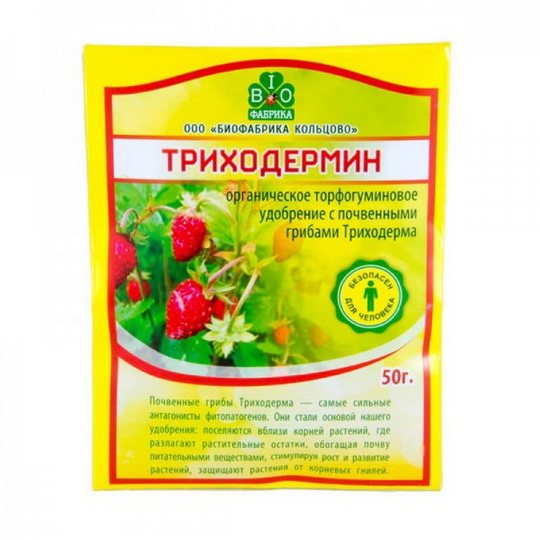

How to spray cucumbers so that the leaves do not turn yellow from diseases?
To combat these diseases, special means are used. It is necessary to understand that already yellowed leaves will not recover, and treatment will help prevent the process of further development of the disease and death of the plant.
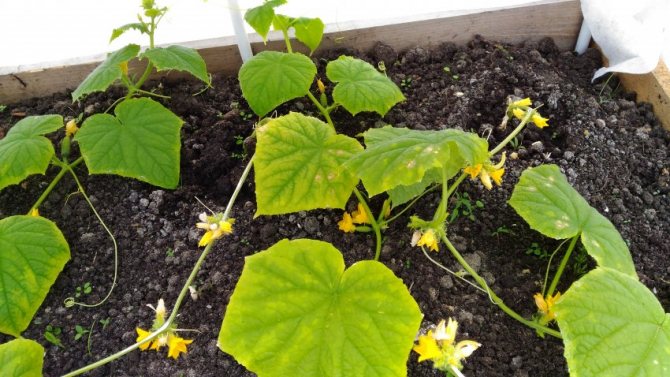

Special biological preparations, which are absolutely safe for humans, can counteract pathogenic bacteria. The composition of the preparations includes beneficial bacteria that have a negative effect on the pathogenic flora.
- How to care for tomatoes - planting, watering, feeding and the main nuances of growing. Tips and secrets of tomato care for beginners (110 photos and videos)
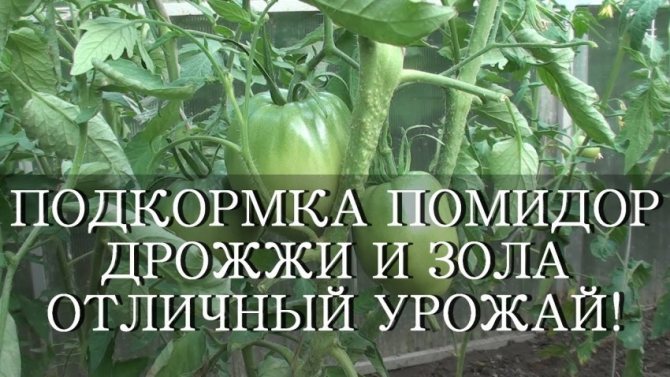

Feeding tomato and cucumbers with yeast: recipes and video instructions on how to properly feed vegetables with yeast (105 photos)
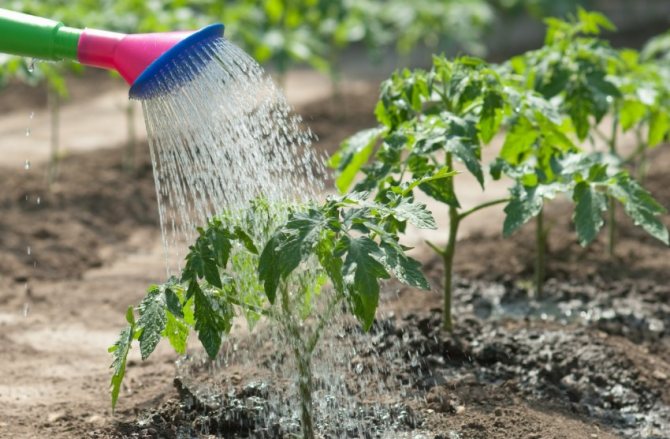

Boric acid for tomatoes: methods of application as fertilizer for the garden and vegetable garden. Expert advice and detailed technology for the application of boric acid to tomatoes (90 photos + video)
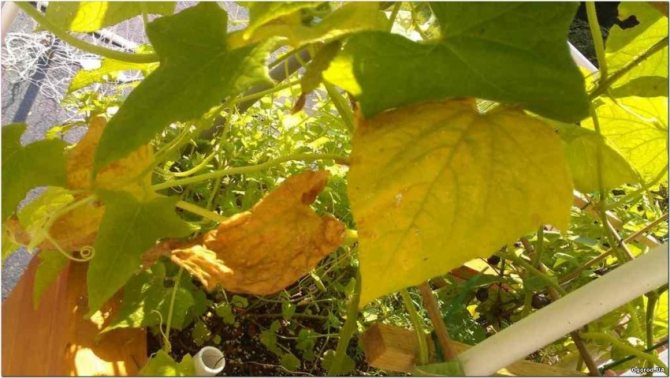

The funds are used to treat both already growing cucumbers and seeds. The main drugs for combating the above diseases include:
- Pentafag-S.
- Alirin-B.
- Planriz.
- Fitosporin-M.
- Gamair.
- Trichodermin.
Yellowing due to improper watering
Improper watering is not only an insufficient supply of moisture to the plants, but also its excess. If you are unsure of how to properly water your vegetable crops, it is best to do your research before you start growing them.
How poor watering affects cucumbers and leaf health
Due to a lack of watering, plants begin to shed their leaves in order to save moisture consumption and not die. Do you know why cucumber leaves turn yellow in drought? It's simple - the beneficial substances from the leaf go into the roots, it changes color, and then dries up altogether. Flowers that require additional nutrition will be dropped in the same way. If the plant does not receive moisture in the next period, it may die.
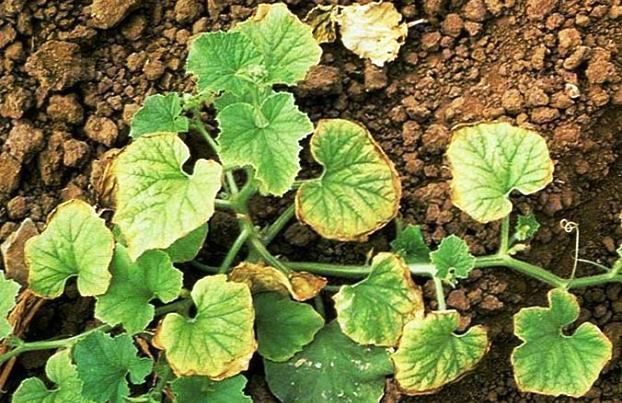

Yellowing of leaves due to lack of moisture
When organizing watering for a cucumber garden, don't make a common mistake. Watering the garden often, but not enough, you do not allow life-giving moisture to get into the deep layers of the soil, where the main roots of the bushes are located.
In order to somehow survive, the plant begins to pull the roots to the very top of the soil, which is why they suffer when the soil is loosened and overheat in the sun.
The problem of excess moisture and its solution
The second side of the coin is too abundant watering of cucumbers, which is performed once a week or even less often. It would seem that the garden has been flooded and you can forget about it for 7-10 days. But this approach harms plants, because the water leaves quickly enough, especially in hot weather, after which the bushes lack moisture. In addition, such watering leads to decay of the root system.


From excess moisture, the leaves can also turn yellow.
How to properly water cucumbers so that their leaves do not turn yellow? You need to understand that the norm for one plant is about 25 liters of water and it should be given 2 times a week. If the weather conditions are very hot or too cool, you can adjust the watering frequency slightly. This approach will allow you to harvest from beautifully shaped fruits with excellent taste.
Could watering be the cause?
Check out these articles as well
- Watermelon variety Sugar baby
- Raspberry jam
- Decembrist flower (Schlumberger)
- Rabbits of breed Gray Giant
Very often, the reason for the yellowing of cucumbers is an abundance of moisture. If there is not enough of it, the plant simply dries, but when there is a lot, the leaves turn yellow. That is why it is not recommended to fill the plant with water for the future if it is very hot outside or too lazy to do it every day.
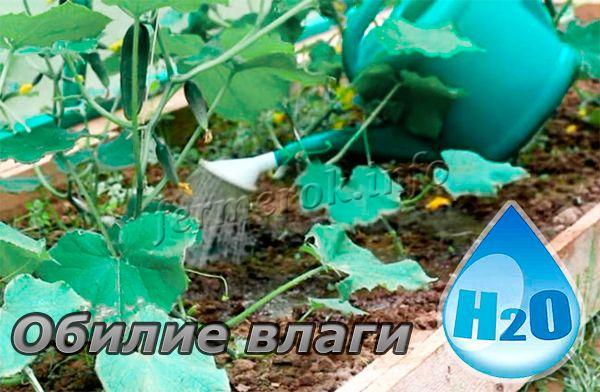

Very often, the reason for the yellowing of cucumbers is an abundance of moisture.
The amount of water for cucumbers depends on many factors: lighting, soil type, season, period of crop development, planting site, level of groundwater, water, as well as variety, and so on. That is why it is difficult to name the exact displacement for each sprout. In order for the plant to always have enough water, you need to use a primitive method - stick your finger in the ground and if it is cool and humid there - watering is not required, if it is dry and hot, then it is necessary.
And one more important point - water warmed up in the sun, settled water is always used for irrigation. The procedure itself is carried out at the root!
Cucumbers description, photo
Cucumis sativus is the Latin name for cucumber. Botanical literature calls it common or sowing. The name is translated from Greek as "immature", which fully reflects the essence of the culture. After all, fruits are used for food that have reached technical maturity, that is, they have gained the appropriate parameters, but with unripe seeds. At the stage of biological maturity, the vegetable looks unattractive - yellowish-brown, with a tough skin, dense fibrous pulp and hard seeds like a melon.
It is interesting! Cucumis sativus is the closest relative of the melon. They are united not only by a common genus, but also by their genetic origin - it is known that of the 7 chromosomes available in a cucumber, 5 were formed thanks to a melon.
At home, the plant climbs up the bushes and trees. Wild species still live in India, China, at the foot of the Himalayas.
The culture is included in the Pumpkin family, its fruits are called pumpkins by botany. The plant is a liana-like herbaceous annual. A long rough stem spreads along the ground, has antennae at the ends, with the help of which it can easily climb to a height of up to 2 meters. The root system is rod-type with an extensive network of small roots. The foliage is heart-shaped, green, petiolate, divided into 5 lobes. Yellow flowers are divided into two types - male and female. To distinguish them is quite simple: the "girls" have a fetal rudiment. The "boys" sit in groups.
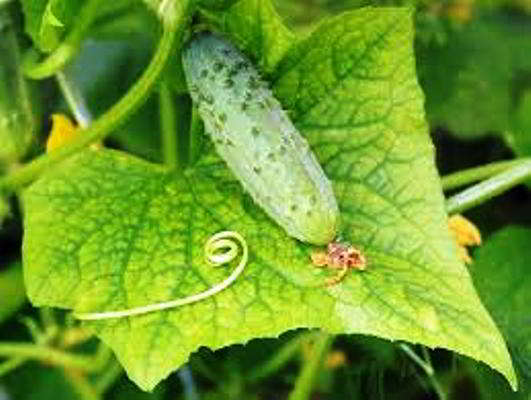

The multi-seeded fruits are distinguished by their juiciness, dense, but tender crunchy pulp. The shape and color of vegetables varies from variety to variety. There are white, green brown, striped cucumbers. The surface of the greenery can be smooth, pubescent, with thorns or lumpy. And the shape of the fruit varies from cylindrical to bizarrely curved.
Nature has laid a large amount of water in the juicy greens - up to 97%. The remaining 3% consists of chlorophyll, vitamins, carotene, ascorbic acid. The vegetable is rich in potassium and magnesium, useful for cardiovascular diseases. The fiber, which is part of the zelents, improves digestion, and a large amount of water allows the vegetable to be used in dietary nutrition.
On a note! Zelentsy remove cholesterol, increase acidity, stimulate appetite, and help the absorption of food.
Cucumbers are used in cooking, medicine and cosmetology. The fruits are eaten fresh, used for preservation, pickling, making mouth-watering salads. Fresh pumpkins are used to make masks and whitening creams, alcohol tincture for oily skin. The pulp is used as a diuretic, normalizes digestion, maintains normal bile viscosity. An infusion of foliage can stop bleeding, heal burns, and soothe irritated skin.
The image of Zelentsy is found on the walls of ancient Greek temples, which testifies to the centuries-old history of culture.In Russia, they knew about crispy vegetables since the 9th century, and during the reign of Peter I, a decree was issued on the cultivation of cucumbers in greenhouses. The culture was grown in greenhouses using various cultivation methods from cold beds to greenhouses on biological "fuel" - manure.
Culture in Russia is in first place in terms of the occupied area of cultivation in greenhouses. The climate of other countries, for example, China, allows for 2-3 harvests of fruits. The largest vegetable is grown in Hungary, its length is 183 cm. The entry is included in the Guinness Book of Records. By weight, the largest fruit weighed more than 6 kg.
Know! Thanks to the work of breeders, there are a lot of hybrids that are distinguished by increased productivity and endurance. And the combined cultivation of cultivars with different periods of technical maturity allows you to feast on greens throughout the summer.
Infection and pests
One of the most common causes of yellowing of cucumber leaves is fungal infection and the action of insect pests. Among fungal infections, fusarium and downy mildew are important.
Fusarium
Infection usually occurs when the weather changes dramatically from hot and dry to cold and damp. Before the appearance of ovaries, lashes infected with fusarians grow without deviations from the norm, outwardly, the presence of infection does not manifest itself in any way.
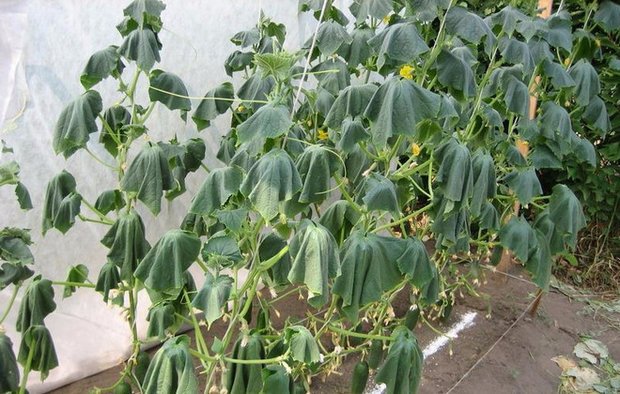

Symptoms of the disease appear when the first ovaries appear. At first, only the leaves turn yellow, the spots on the surface have a yellow-rusty color, they are small, but gradually increase in size until the entire leaf turns yellow. Then the whole lash withers away.
The pathogenic effect of the fungus is associated with the release of toxic substances by it, which prevent nutrients from penetrating into plant cells. The pathogen lives in the soil, therefore, to combat it, it is necessary to replace part of the soil with a new one before planting. To reduce the risk of fungal infection, the planted cucumber varieties should be rotated every season.
Powdery mildew
This fungal disease is associated with a violation of the processes of photosynthesis in diseased leaves. This leads to the formation of small white-yellow spots on their surface, which gradually cover the entire leaf. After this, the infectious process affects the entire lash, which leads to further death of leaves and fruits.
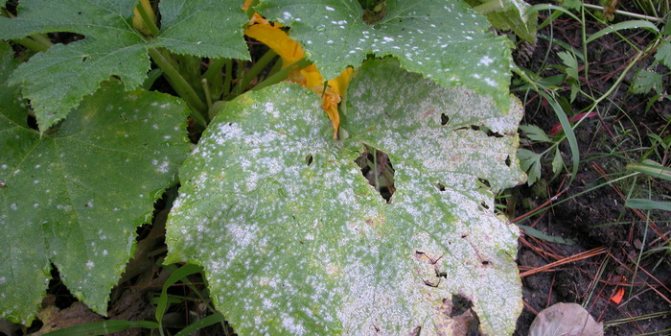

To prevent this disease, you should choose cucumber varieties that are resistant to the fungus. In addition, the soil should be treated with a solution of potassium permanganate every year.
You can distinguish a fungal disease from other causes of yellowing of leaves by the way the cucumber lash responds to watering. If there is no improvement in the condition, this indicates an infectious cause.
More details about this disease in our other article: How to deal with powdery mildew on cucumbers. Review of folk remedies and drugs
Downy mildew
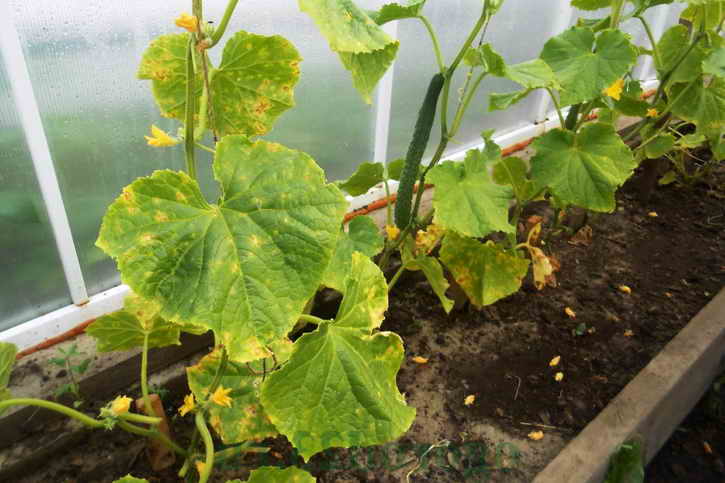

This disease occurs in cucumbers that are planted too close to each other. Excessive humidity in the air and soil in the greenhouse also contributes to the disease. The first manifestations of pathology differ little from other fungal diseases. Downy mildew is also characterized by the appearance of small yellowish spots on the surface of the leaves.
A distinctive feature is that areas of discoloration of the leaf are limited by veins. Over time, the shade of the spots becomes darker to brown. On the reverse side of the leaf, in place of the spots, a gray-brown bloom appears. The disease develops quickly, and if you do not get rid of it when the first symptoms appear, the whole lash will die.
Root rot
This disease can also cause yellowing of cucumber leaves. Significant temperature drops during the day and at night, pouring cold water on the whips can contribute to the onset of pathology.Weakened bushes are most susceptible to disease, after which harmful microorganisms penetrate through the soil into other lashes.
To prevent the disease, you should treat the area twice a summer with special preparations, for example, "Previkur", "Trichodermin". You can find out how to use it in the instructions.
Pests
Some insects cause a lot of harm to cucumber bushes. Representatives of such pests are spider mites and melon aphids.
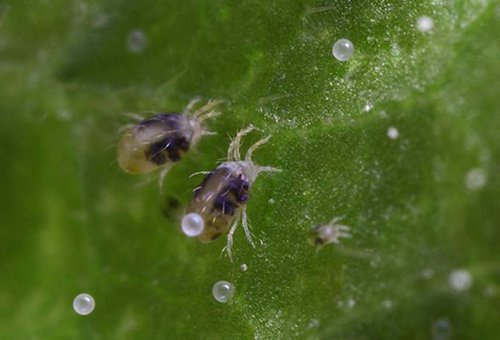

Both species settle on the underside of the leaves and feed on the sap of the cucumber plant, which loses strength and gradually dies. In this case, only the complete destruction of pests can help. To do this, you can use the drugs "Akarin" or "Fitoverm" according to the instructions for use.
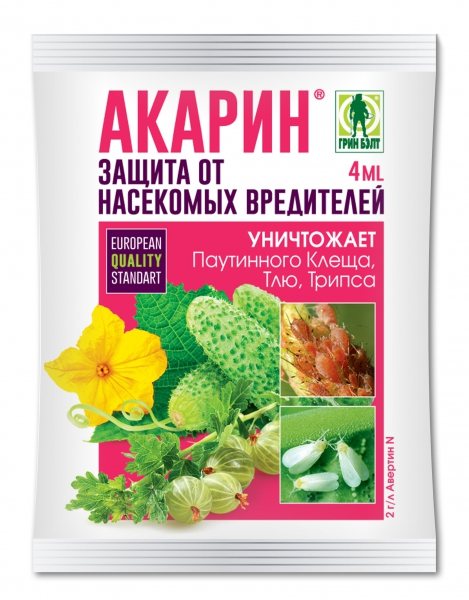

Read more in our other article: Aphids on cucumbers below the leaves: how to fight?
The reason for the yellowing of leaves in cucumbers No. 1: lack of lighting
If the old lower leaves of the cucumbers have turned yellow, do not worry - for cucumber "jungle" this is more likely the norm. Plants grow a large green mass and light hardly penetrates inside.
What to do: in general, you don't have to worry. But for good development and fruiting, do not thicken the planting of cucumbers, tie and form whips, and regularly remove old yellowed leaves.
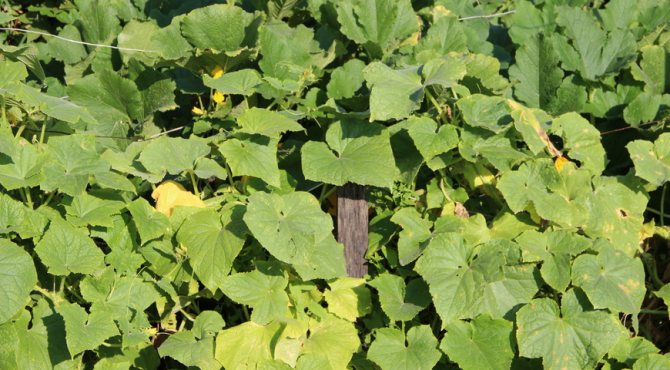

Cucumbers turn yellow - how to fight
Fight yellowing cucumbers
How to deal with such phenomena as yellowing of cucumber leaves, germs and fruits? Let's analyze each reason separately.
Violation of watering rules. Cucumbers are very moisture-loving, and they react painfully to lack of water. However, excessive watering can lead to the same problem - yellowing.
When growing cucumbers, it must be borne in mind that before the beginning of fruiting, the moisture content of the soil, open or protected, should be lower than during the growth of the fruits, and during the mass ripening of zelents, the soil should be saturated with moisture as much as possible. It is categorically impossible to water cucumbers with cold water - this leads to yellowing and falling off of the ovaries. Water must be poured under the stem so that drops do not fall on the leaves and fruits, since burns can form in these places.
The best time to moisten the soil in cucumber beds is early morning or evening. Ground cucumbers are usually watered three times a week, and in dry season, daily, in greenhouses, due to the higher temperature, plants are watered 4-5 times a week.
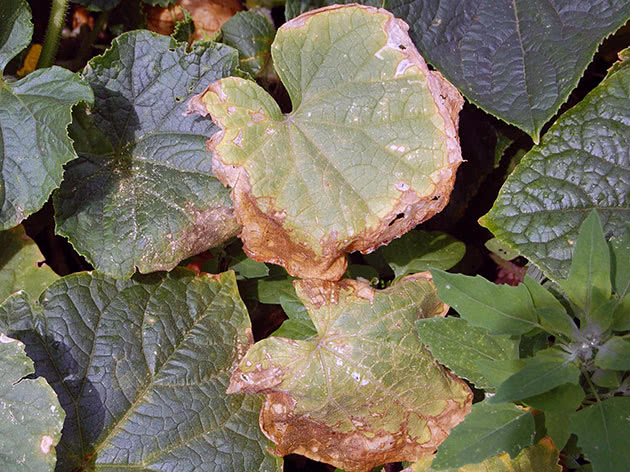

Insufficient lighting. The lack of light has a detrimental effect on the growth and development of cucumbers, therefore, when installing a greenhouse or choosing a site in the garden, one should take into account the extreme dependence of the culture on this factor. In addition, when planting seedlings or sowing seeds of cucumbers, it is necessary to follow the recommended scheme so that each plant has sufficient nutritional area for growth and development and the maximum amount of sunlight.
- Chlorosis: treatment and prevention, control measures
For example, parthenocarpic varieties and hybrids are planted one per m², and bee-pollinated ones - 2-3 bushes per m². If you save space by planting seedlings too closely, the grown plants will shade each other, and as a result, their leaves and ovaries will begin to turn yellow and fall off.
But be prepared and protect your cucumbers from too much light, especially when a prolonged dry heat sets in, because the summer sun can not only warm, but also burn.
Growing cucumber seedlings at home
The ovaries of cucumbers also turn yellow from an irresponsible attitude to such a procedure as the formation of a bush. Cucumber bushes begin to form with "blinding" - the removal of rudimentary elements in the leaf axils. How many of them to remove on one plant depends on the variety of cucumbers: on the bushes of the bee-pollinated variety, three sinuses are blinded, and on parthenocarpic cucumbers - at least eight.
Then you need to pinch the shoots as they grow back.If this is not done in a timely manner, they will grow, and the bushes will begin to shade each other. To prevent this from happening, the upper part of the shoots is pinched after regrowth by 20 cm, because longer shoots weaken the plant and lead to yellowing of the ovaries.
Violation of the temperature regime. No gardener is immune from sudden temperature changes or sudden frosts, even when it comes to growing cucumbers in greenhouses. For example, greenhouses with a film cover allow heat to pass through during the day, and the air inside can even heat up to 40 ºC, but at night the film releases the heat, causing the temperature in the greenhouse to drop sharply. Here is the reason for the yellowing and even dropping of the ovaries. To avoid temperature extremes, it is necessary to provide for additional covering of cucumbers at night with a film or non-woven covering material - agrotex, lutrasil or spunbond.
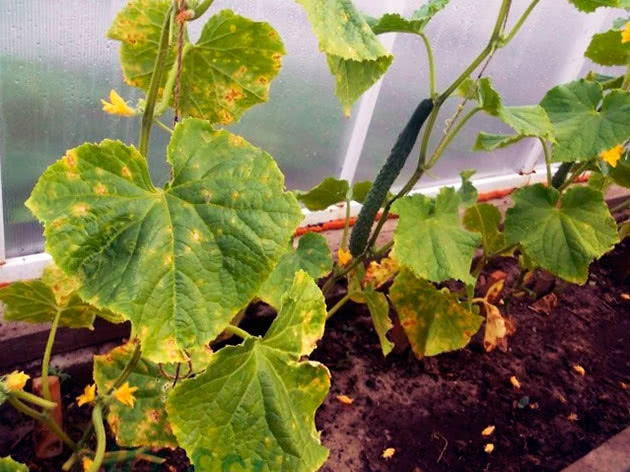

The optimum temperature for parthenocarpic cucumbers before fruiting is considered to be:
- in clear weather - 22-24 ºC;
- in cloudy weather 20-22 ºC;
- 17-18 ºC at night.
During the fruiting period, the temperature is maintained within the following limits:
- 23-26 ºC in clear weather;
- 21-23 ºC in cloudy weather;
- 18-20 ºC at night.
For cultivation of bee-pollinated varieties, temperature indicators should be higher than for parthenocarpic ones by 1-3 degrees.
As for the soil temperature, the most comfortable range for cucumbers will be from 22 to 24 ºC, and the critical mark of the thermometer is 13-15 ºC - if the temperature drops below, the roots will stop absorbing nutrients, and the cucumber ovaries will begin to turn yellow and fall off.
Violation of mineral nutrition. Soil composition. When choosing a site for cucumbers, it is also necessary to ensure the quality of the soil suitable for the culture. The soil for cucumbers is preferable loose, moist, air and moisture permeable. As for nutrients, their amount in the soil must be balanced, otherwise the leaves and embryos of cucumbers will begin to turn yellow. And problems with an imbalance of minerals in the soil are very likely, since the abundant and frequent watering that cucumbers require, flushes potassium, nitrogen and other elements important for the plant out of the soil.
How to determine which mineral is lacking in plants? By external signs: for example, yellow spots on the leaves indicate a lack of potassium, discolored and yellowing leaves, thinned lashes - symptoms of a lack of nitrogen, a yellow edging on the lower leaves of cucumbers indicates a deficiency of magnesium, yellowing young leaves indicate that plants need copper, yellow spots and bright green veins on the leaves indicate a lack of iron, and from a lack of zinc, the edges of the leaves of cucumbers turn yellow, and the lower leaves die off.
Therefore, regular feeding of cucumbers with nitrogen-potassium-phosphorus fertilizers is necessary, especially during the fruiting period, as well as processing plants on the leaves with solutions containing other important elements. A simple but effective feeding of cucumbers is herbal infusion.
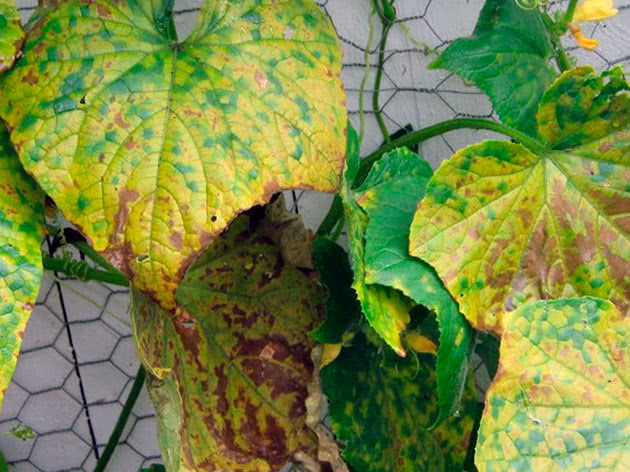

Poor greenhouse pollination of cucumbers. When choosing varieties of cucumbers for growing in a greenhouse, give preference to parthenocarpic and self-pollinating ones - those that do not need pollinating insects. If you grow bee-pollinated varieties, then plant honey plants in the greenhouse to attract bees and arrange daytime ventilation so that insects can enter the greenhouse. For the formation of full-fledged ovaries, spraying cucumbers with a solution of boric acid and Bud or Ovary preparations is effective.
Sometimes cucumbers form too many ovaries. In this case, you need to carry out immediate pinching or simply remove excess embryos - there should be no more than 30 of them on one bush, otherwise the ovaries will begin to turn yellow and crumble, and the plant will waste nutrients on them.
- Chlorosis: treatment and prevention, control measures
Diseases of cucumbers. When growing cucumbers, it is necessary to observe crop rotation - do not plant a crop in the area after pumpkin seeds - and take preventive measures against infection of plants with diseases such as root rot, fusarium wilt, pityosis, peronosporosis, ascochitis, tobacco mosaic and bacteriosis.
A preventive measure is the treatment of cucumbers with a biological preparation Trichodermin, harmless to humans and animals, but suppressing pathogenic fungi. But if you still find symptoms of a fungal disease on cucumbers, spray the plants with one percent Bordeaux liquid. Unfortunately, infections of viral origin - mosaic or bacteriosis, for example - are incurable, so you need to remove the affected specimens from the garden as soon as possible and treat the soil in which they grew with a 5% formalin solution.
Pests of cucumbers. Most often, cucumbers suffer from melon aphids, whiteflies and spider mites, which feed on the cell sap of the leaves. As a preventive measure against pests, we recommend that you regularly destroy weeds during the growing season and plant residues after its end. In case of mass destruction of cucumbers by insects, it is necessary to treat the plants with insecticides Aktara, Aktellik or Fufanon, but it is better not to resort to such strong and unsafe preparations, but to use folk remedies against pests.
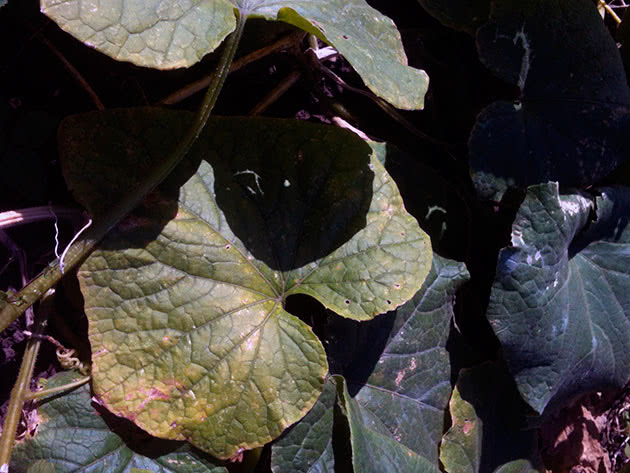

Diseases leading to yellowing of cucumber leaves
Yellow leaves on cucumbers can be caused by the following diseases:
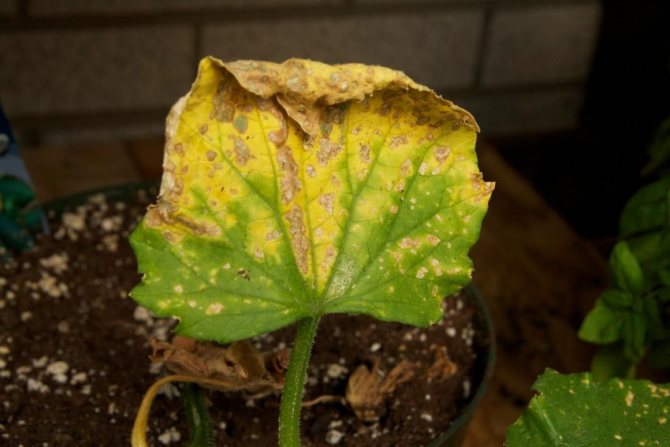

Cucumber mosaic. A viral plant disease that affects only the formed leaves after planting. The disease is carried by aphids.
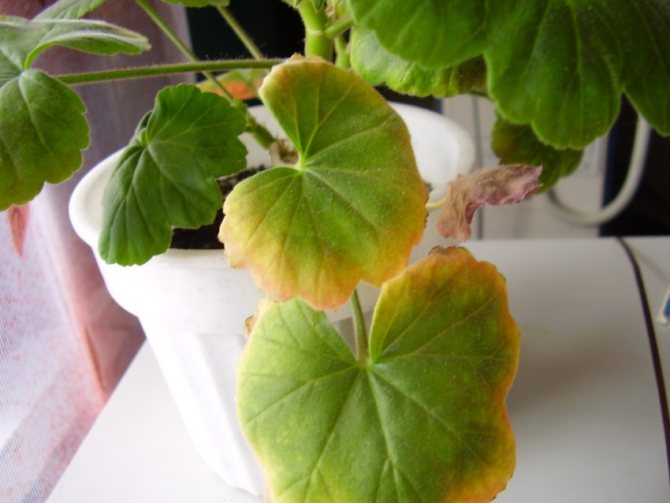

Pitioz. Fungal infection leading to the degradation and death of the cucumber root system. The disease can develop only if there is unbound moisture in the soil.
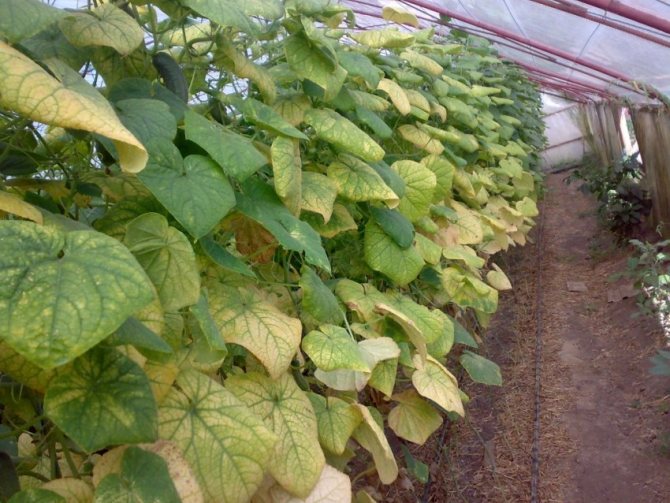

Fusarium. The disease is also a fungus, due to which the stems of the plant lose their thickness, and the tissues acquire a brown tint. An active catalyst for the development of the disease is increased soil moisture.
Peronosporosis. This disease affects most crops at every stage of development, including at the germination stage. The disease is also fungal, and its cause is infection with harmful spores.
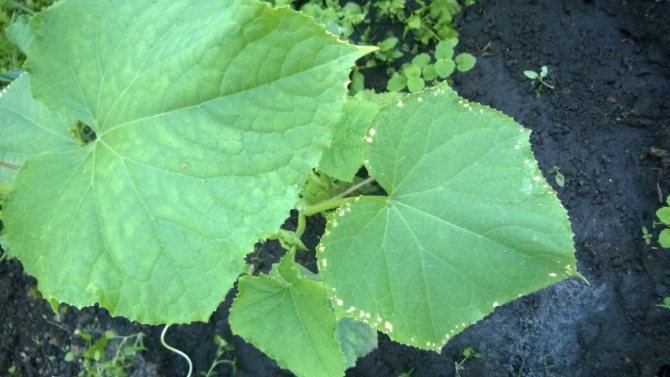

Diseases of cucumbers
Fungal diseases are directly related to the external growing conditions. If the weather is cold or it rains, then after them you can expect an outbreak of fungal infection. You can spray with a solution of ash and laundry soap or use chemicals. The most diseased plants must be rooted and burned.
Do not be afraid of the dying off of the old lower yellow leaves on the cucumbers. This happens closer to autumn and is a natural process. If everyone else looks good and the fruits continue to ripen, then there is no problem.
Preventive measures
To grow a healthy plant, it is necessary to resort to preventive measures in advance:
- plant a crop every time in a new place, maintaining an optimal crop rotation;
- watering is carried out only with warm water 1 time in 2-3 days, in the heat you can carry out the procedure daily;
- maintain optimal temperature (during the day - + 20 ... + 24 ° С, at night - + 18 ... + 22 ° С) and humidity (75–90%);
- avoid shading or bright direct rays;
- water only at the root;
- feed the bushes with mineral and organic fertilizers, saturating the soil with sufficient phosphorus, nitrogen and potassium for vegetation;
- to prevent fungal diseases with fungicides, for example, Bordeaux liquid.
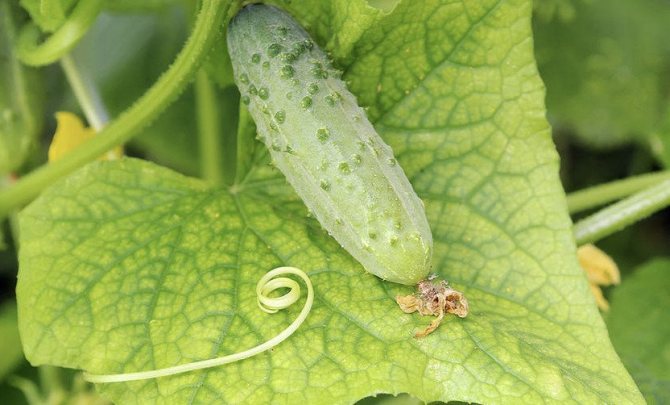

Yellow leaves in cucumbers can be the result of one of many problems. With proper treatment, the vegetable grower will surely be able to save the plant and harvest a rich and healthy harvest.
Seedlings are ill: the most common causes
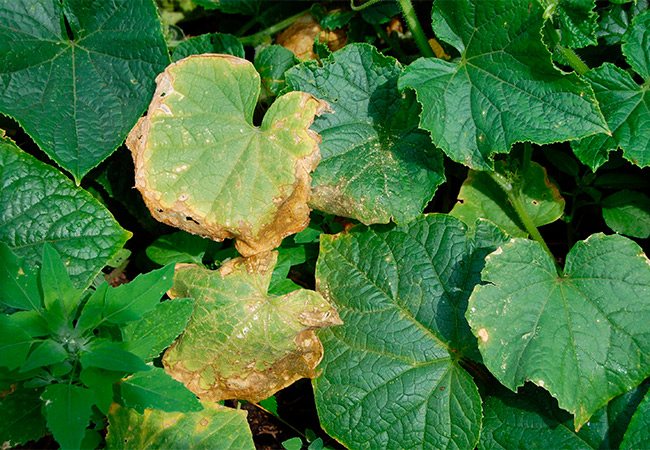

If the leaves of cucumbers turn yellow, most often they do not have enough light, a small container volume, which does not allow the roots to fully develop and nourish the aerial part. Ambient temperature is also of great importance, as is the degree of soil moisture.
Young seedlings are very sensitive to the lack of beneficial trace elements and can react with yellowing of the leaves. Therefore, it is necessary to make top dressing on time, especially potash, and when transplanting, try to avoid mechanical damage. If you sowed seeds in peat pots, then directly in them and deepen the seedlings into the ground.
Have questions? Ask and get useful advice from professional gardeners and experienced summer residents. Ask a question >>
Incorrect spraying
For foliar treatments, you need to choose the morning time so that the leaves have time to dry by lunchtime. Or evening when the sun goes down completely. The presence of chemicals in the solution provokes a burn. Most likely, there will be yellow spots on the leaves of the cucumbers, which then dry out and turn into holes.
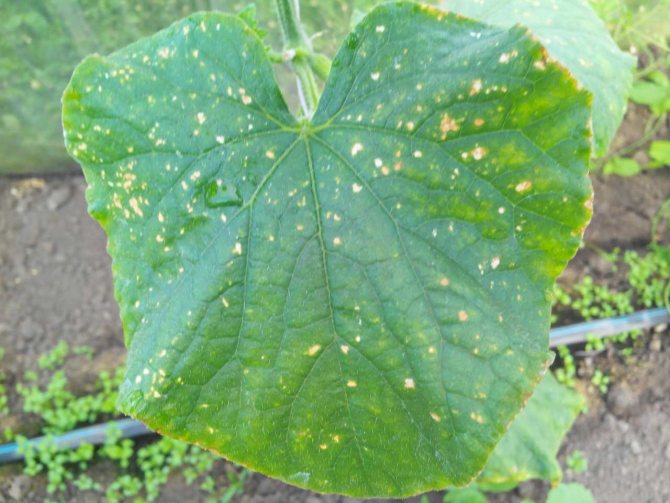

How pests destroy cucumber leaves
If insects reach the cucumbers, the leaves of the plants may turn yellow, because vital parts of the bush are attacked. You may encounter such pests:
- ants;
- melon aphids;
- slugs;
- spider mite;
- whiteflies.
Spider mite and whitefly control
The spider mite is one of the most dangerous pests that feeds on green cucumbers and lives under the leaves. Especially a lot of ticks appear in the hot months, when they are able to destroy an entire garden. To combat the pest, you need to disinfect the site by treating the ground with an infusion of onion husks (about 200 grams of dry husks per 10 liters of water). Watch out for watering - the mite loves dry areas.
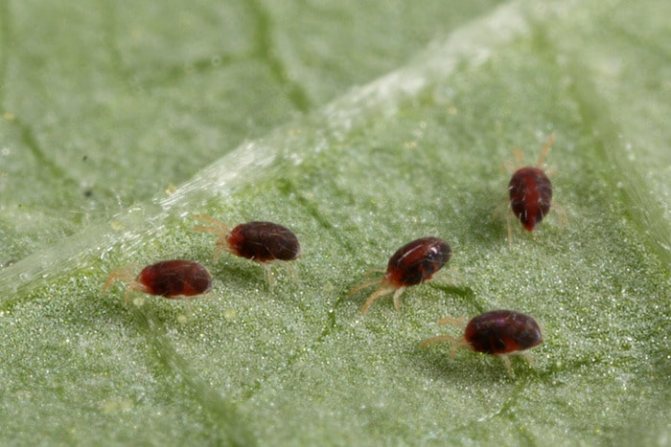

Spider mite is a dangerous pest
Whitefly is a very prolific insect that plants its larvae on cucumbers.
They suck the sap from plants, so their leaves can turn yellow. It is difficult to fight the whitefly, so it is better to immediately resort to spraying the beds with special preparations. Growing tobacco near cucumbers will also help, because the insect does not tolerate its smell.
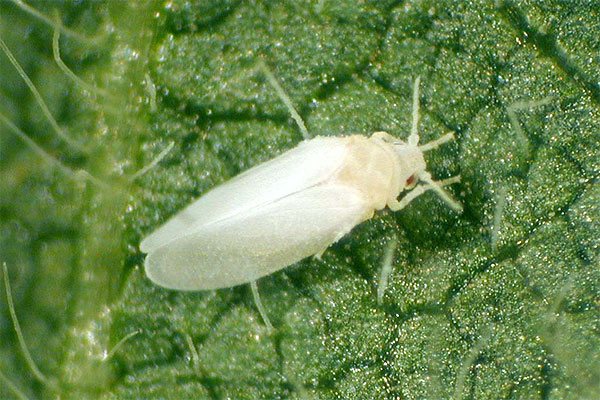

What does a whitefly look like?
How to get rid of slugs, ants and aphids
You can get rid of slugs and ants by regularly loosening the soil and using baits. For ants, they are made from bottles of sweet water, and for slugs, from pieces of cardboard or planks, under which insects will hide at night. Early in the morning, traps should be removed along with the pests caught in them and taken away.
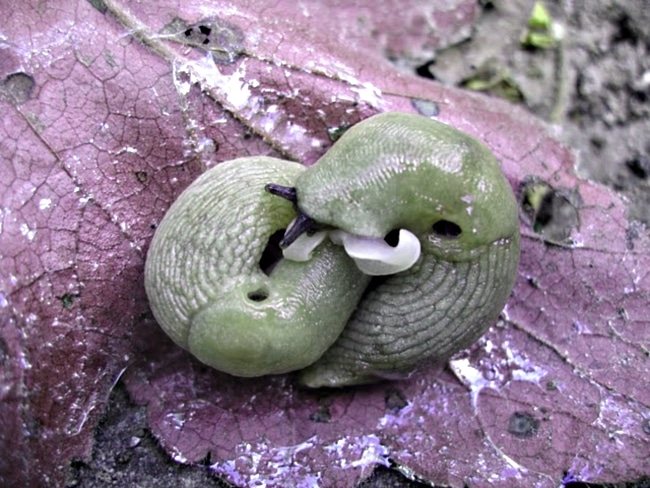

Slugs feed on cucumber leaves and harm plants
Another dangerous pest is aphids. If you notice her colony in your garden, try to immediately destroy all the weeds that surround the cucumber garden, because these insects can live on them.
Also spray all plants with wood ash solution. To prepare it, mix 400 g of ash and 100 g of grated laundry soap in 20 liters of water (this is necessary for better adhesion of the solution to the leaves).
What diseases cause yellowing
Diseases are one of the most unpleasant reasons why the leaves of cucumbers turn yellow, because because of this, you can lose the crop. Unfortunately, not all stages of the disease can be treated equally effectively, so it is so important to identify the problem in a timely manner. It is worth knowing the main diseases of cucumbers, from which the color of the leaf plate changes.
Yellow leaves due to powdery mildew
The first signs of powdery mildew are the appearance of a white or slightly reddish bloom on the leaves. When the plaque spreads to the entire leaf, it will begin to turn yellow and dry. As a result, the cucumber crop may die, because the disease negatively affects fruiting.
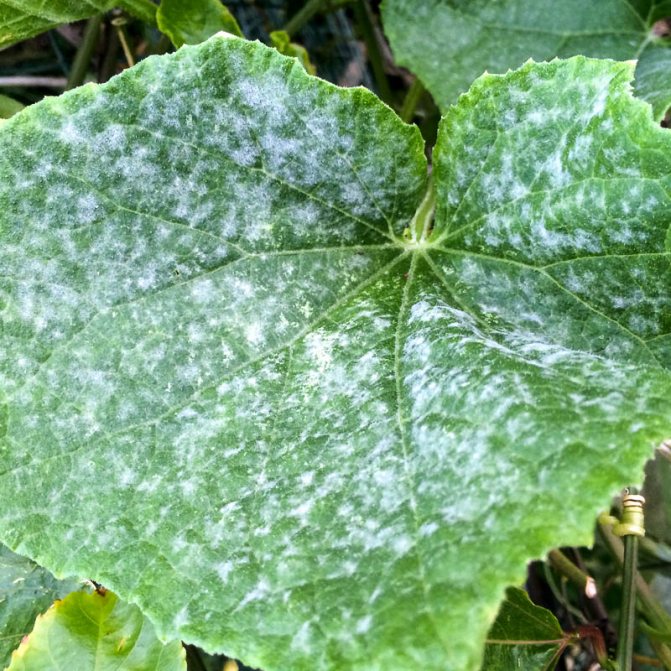

The first sign of powdery mildew is white spots on the leaves.
Control methods:
- treatment of plants with a preparation containing copper;
- spraying with fungicides as soon as you see white spots;
- treatment of both sides of the leaves with a 20% solution of colloidal sulfur;
- spraying with a solution of soda and laundry soap - dissolve 50 g of each component in 10 liters of heated water.
Rusty spots from downy mildew
If you find small yellow specks on the leaves of cucumbers, it could be downy mildew. If the plants are not treated in time, the spots of peronosporosis will grow and turn brown in 5-7 days, after which the leaves will begin to dry out.
Usually, the disease develops due to the introduction of a fungus on the site, but it can also be provoked by watering with cold water.
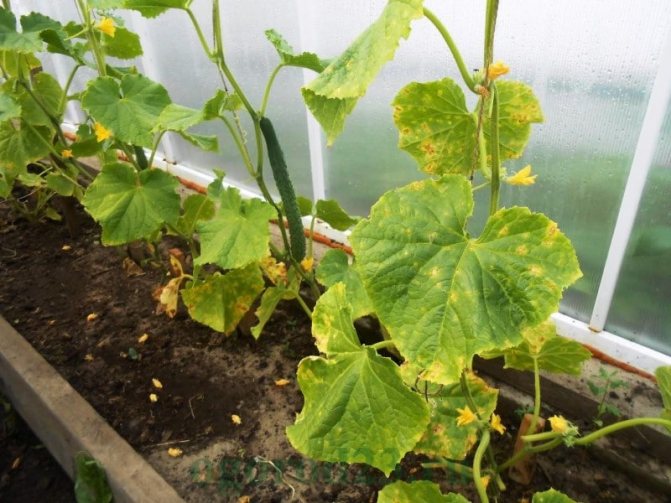

What does peronosporosis look like on cucumbers
What to do to save plants from downy mildew:
- when determining the disease, stop watering and fertilizing the garden with cucumbers;
- spray the plants with copper oxychloride or polycarbonate in the proportion indicated by the manufacturer;
- you can spray cucumbers with "Ridomil" or "Ordan", covering them with foil overnight.
Root rot is a dangerous disease
Cucumber leaves can turn yellow due to root rot, which attacks plants in hot weather if not properly watered. At first, the bushes turn yellow, then they begin to fade, and the roots become rotten and acquire a rusty hue. To prevent root rot, you need to remove plant residues from the site in time and water the garden correctly.
Methods for dealing with root rot:
- stimulate diseased plants to put down new roots;
- pour a layer of fertile soil 6-7 cm high around the bushes;
- cut off the lower leaves and press these stems against the loose soil;
- water the plants only with warm water, but not at the root.
Yellow leaves from fusarium
Fusarium wilt usually begins during the period of active fruiting, therefore, the plants affected by the disease do not give themselves away during flowering. The disease can develop quickly when there is a lack of moisture in the soil and high air temperatures. The reason for the wilting and yellowing of the leaves is the blockage of the plant vessels that conduct water from the roots along the stem.
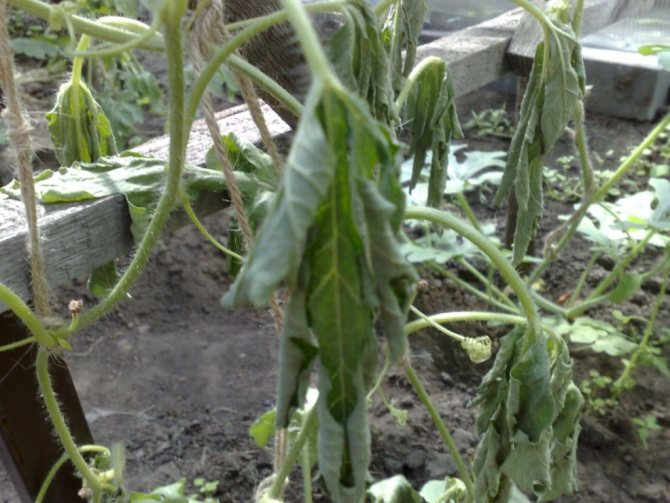

Fusarium wilting of cucumbers is difficult to cure
If you notice brown vascular bundles on the plants, immediately treat them with a fungicide, repeating spraying a week later. It is very difficult to treat fusarium, so your task is to at least slow down its development in order to have time to harvest.
Preventive measures are to treat seeds and soil before sowing cucumbers or planting seedlings.

